

Prior Episodes | 7981 (4 ABY) | Next Episodes
Continuity & Analysis
Star Wars - Episode VI - Return of the Jedi (1983)
Luke Skywalker has returned to his home planet of Tatooine in an attempt to rescue his friend Han Solo
from the clutches of the vile gangster Jabba the Hutt. Little does Luke know that the GALACTIC EMPIRE
has secretly begun construction on a new armored space station even more powerful than the first
dreaded Death Star. When completed, this ultimate weapon will spell certain doom for the small band
of rebels struggling to restore freedom to the galaxy...
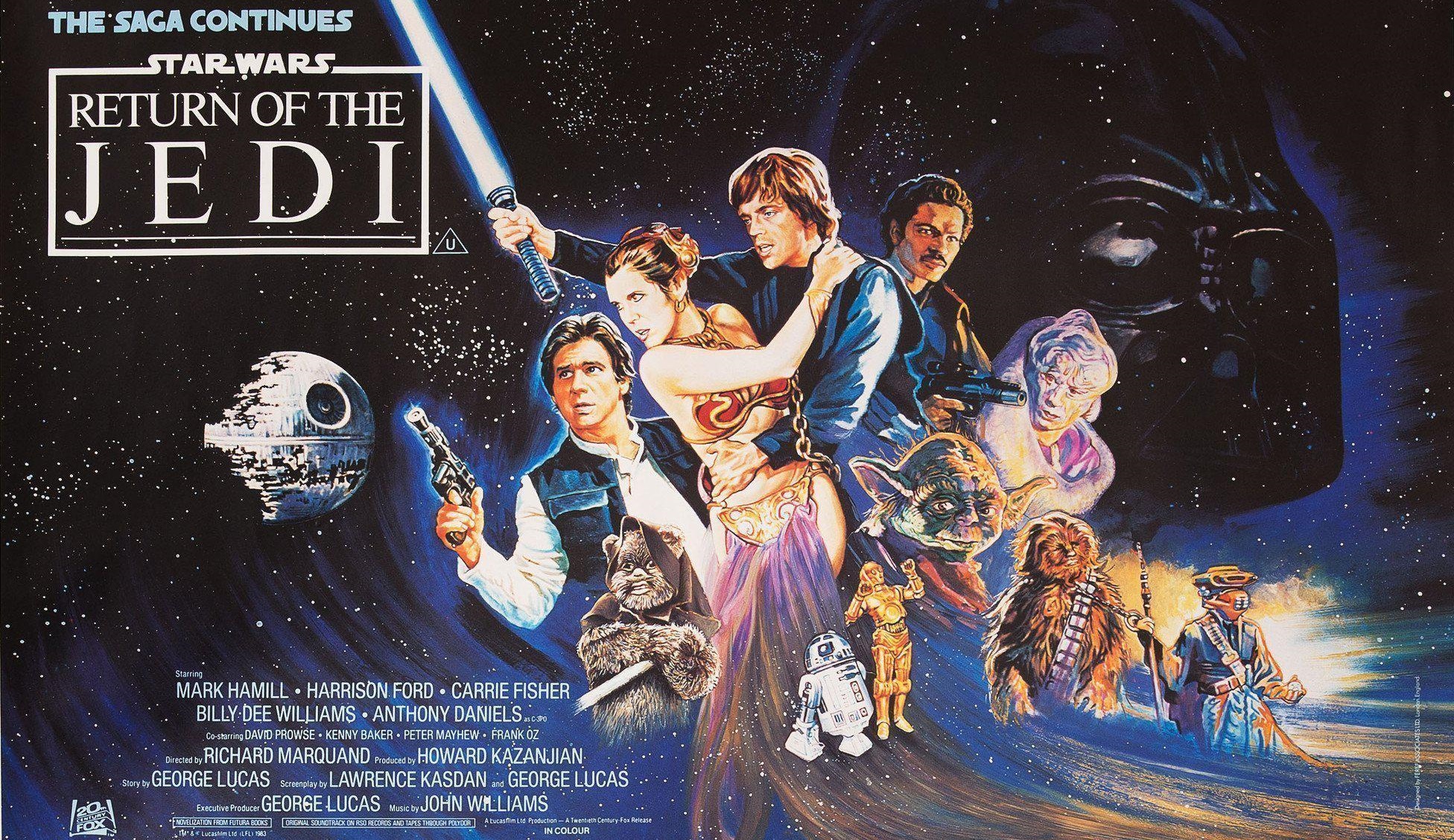

CONTINUITY
Episode VI takes place in the year after Episode V, and four years after Episode IV.
The planetary moon Endor is seen for the first time. Three worlds are the setting of this film:
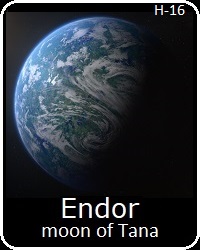


This film takes place over the course of 5 days. Day 1 - Vader's arrival --> Leia unfreezes Han. Day 2 - Luke arrives on Tatooine --> Leaving Tatooine.
Day 3 - Luke on Dagobah. Day 4 - Rebel briefing --> Luke surrenders to Vader. Day 5 - The Battle of Endor --> Ewok dance party.
Originally called Return of the Jedi, writer Lawrence Kasdan suggested that was a weak title for an adventure film. During production
the film was titled Revenge of the Jedi, however about two months before the release, George Lucas decided the title was
inappropriate as the Jedi do not seek revenge, and returned to the original title. During filming in the United States, the film
was given the fake working title of Blue Harvest, with the tagline 'horror beyond imagination', to avoid attracting attention.
Four more planets are seen in the Special Edition during the galactic party montage, making a total of seven worlds seen in this film:
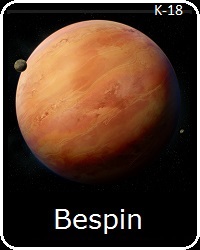
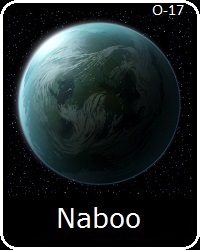
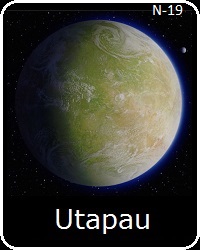

- An uncertain amount of time has passed since Episode V and the beginning of this film, and estimates usually range from six months to
a year later. There are several factors such as Death Star construction, Luke's progress, and the state of the Alliance which favor longer
estimates. Factors such as Han being frozen and more likely implications of Luke's conversations with Yoda favor shorter estimates.
- The second Death Star was 125% of the size of the first Death Star, making it 200 km wide. Construction began shortly after the destruction of
the first station 4 years earlier. Much less time would be needed to complete this Death Star. Having perfected the physics and engineering of
the main weapon at the completion of the first station. As a result, the main weapon could be completed before much of the superstructure
was in place, as the Emperor ordered that the station be fully armed as soon as possible. This project's scale and its urgency required aggressive
resource extraction, massive labor forces, and huge fleets of construction and supply ships. The station was constructed in orbit of Endor,
in a remote and isolated sector of the Outer Rim, near to the Unknown Regions.
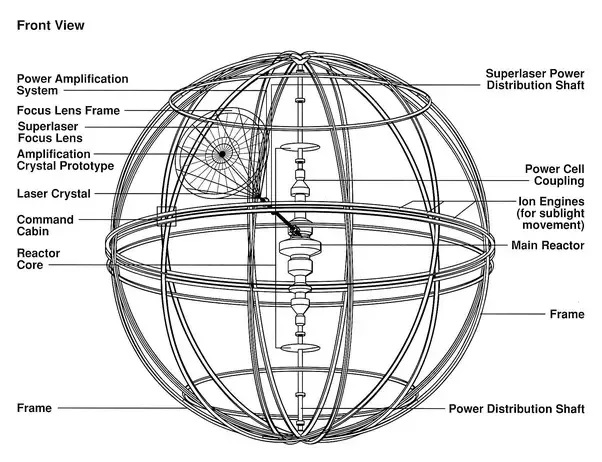

- Endor is a gas giant planet with a number of moons, located in the Moddell Sector, beyond the Western Reaches in the Outer Rim. At least one of its
moons is habitable and inhabited, known as the forest moon or the sanctuary moon. This moon is also referred to as Endor in the film, much
the same way that "the sixth planet of the Hoth system" is usually referred to as Hoth. According to supplementary material, the locals on
the Forest Moon call the gas giant planet 'Tana', so that name is often used in supplementary material to distinguish it from the moon Endor.
- Vader's shuttle is designated ST-321, and is commanded by Colonel Jendon and piloted by Captain Yorr. Both officers are part of Onyx Squadron,
a division of the Imperial Starfighter Corps. The shuttle is a Lambda-class T-4a shuttle which is a product of Seinar Systems developed by
Cygnus Spaceworks, featuring their characteristic fold-up wing design and Greek letter class designation.
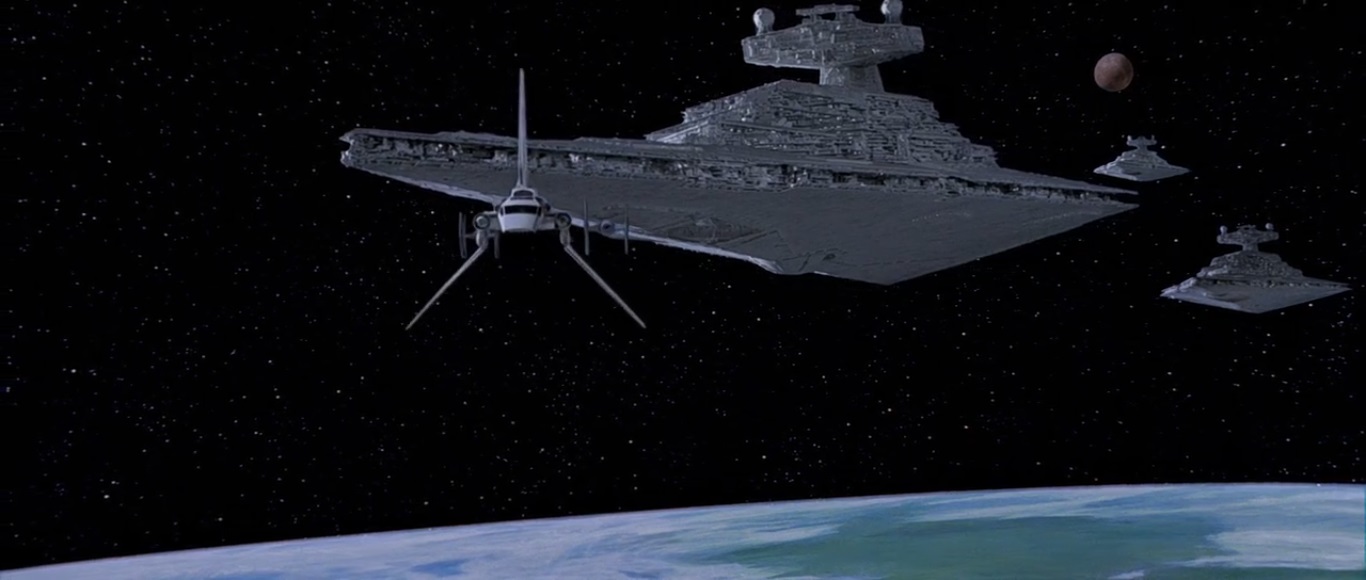
- The "security deflector shield" which surrounds the Death Star emanates from a large shield generator located on the surface of the forest moon.
Ships are unable to pass through the shield when active, and the shield likely can withstand bombardment with energy weapons. Shield
generators of this size and energy may be capable of shielding an entire moon, particularly if it is small, however this is not certain.
Main Article: Shields, Deflectors, and Ray Shields
- The computer screen which shows Vader's shuttle and its clearance code is written using the Aurebesh alphabet, the first example of this script
ever seen. The readout is evidently some kind of code, as it is a string of meaningless letters some of which repeat rather than a readable text.
The names of the letters and their corresponding letters in the Latin alphabet were developed in legendary and supplementary material in
the early 1990s, and were fully embraced and utilized in the prequels and subsequent SW material.

This entire film is a continuity error in terms of Imperial rank insignia. This is widely believed to be due to a costuming
error. Almost every officer was the same insignia worn by Navy Captains in Episode V, even Moff Jerjerrod, while other
officers were given no insignia at all. The Rebel insignia are also suspect, with the domino-style insignia formerly used
for officers absent, which could also have been an error, considering the degree of the error with the Imperial ones. This
is all discussed in the main article about ranks and rank insignia, as are issues this created in supplementary material.
Main Article: Ranks and Rank Insignia
- Moff Jerjerrod is the commander of the second Death Star and in charge of its construction. While he is identified as a Moff by credits, he is always
referred to as "Commander", first by Lt. Endicott and Vader, and later by the Emperor. This is a reference to his position as the commander of
the station rather than his actual rank, as is the case with the term commander in both Earth history and other SW material. This instance has
caused additional confusion due to the film-wide costuming error which has given him an insignia that a rank Commander might wear.
Main Article: Ranks and Rank Insignia

After speaking with Jerjerrod, Vader was to have taken an elevator to a room with a pressurized chamber like the one
he used in Episode V. From there he uses telepathy to call to Luke through the Force, and once again invite him to
join him on the dark side, and tells Luke that it is inevitable. This was intended to be one of the inversions of the prior
film, placing this scene at the beginning in a reversal of when Vader did the same thing at the conclusion of Episode V.
This was removed because it dramatically undercut Luke's first appearance in this film, where his actions, dress, and
demeanor are all intended to show that Luke may be headed down the same dark path as his father. The scene with
Vader calling out to Luke took us to Luke in a cave on Tatooine, making adjustments to the lightsaber he has built, which
was intended to explain where Luke's new lightsaber came from. Lucas ultimately decided this didn't need to be shown,
and that showing Luke here further undercut his entrance. Luke is next to R2, but we are not actually shown him giving
R2 the lightsaber. Nevertheless, leaving out this scene makes it much more of a surprise when R2 launches it to Luke at
the critical moment. That is not to say these events didn't necessarily happen, they just didn't help the storytelling.
- Lando and Chewie "never returned" from Jabba's place according to C-3PO, as this plan has obviously been in the works for some time.
Lando has insinuated himself amongst Jabba's personal guard. Chewie has been at sometime joined up with Leia, who is posing as
a bounty hunter who has captured him. This is the main part of the plan to free Han, although it may be that Luke knows they will
be unlikely to break out Chewie, the droids, and for all to escape, so it is likely Luke fits into the primary plan somehow should this
work. Luke has given R2 his lightsaber, so it seems the main goal of Leia's infiltration is to unfreeze Han so that they can be rescued.
- Jabba the Hutt's palace is a large fortress located in a remote area of Tatooine relatively near to the city and spaceport of Mos Espa. According to
legendary material it is a repurposed monastery of Ba'omar monks, which was made essentially canon based on the architecture of a Ba'omar
monastery seen in The Clone Wars. Originally built in 7277 (700 BBY), it was at some point taken over by organized crime, and ultimately
fell under Hutt control. While outside of Hutt space, Tatooine is in an adjacent region, and ruling over this territory as a personal fiefdom allows
Jabba a degree of separation from the politics of Nal Hutta and the Hutt Council, of which he is the leading member. Tatooine gives Jabba a base
of operations which is far from his meddling competitors, and its status as an unincorporated Rim world provides him with a measure of security.
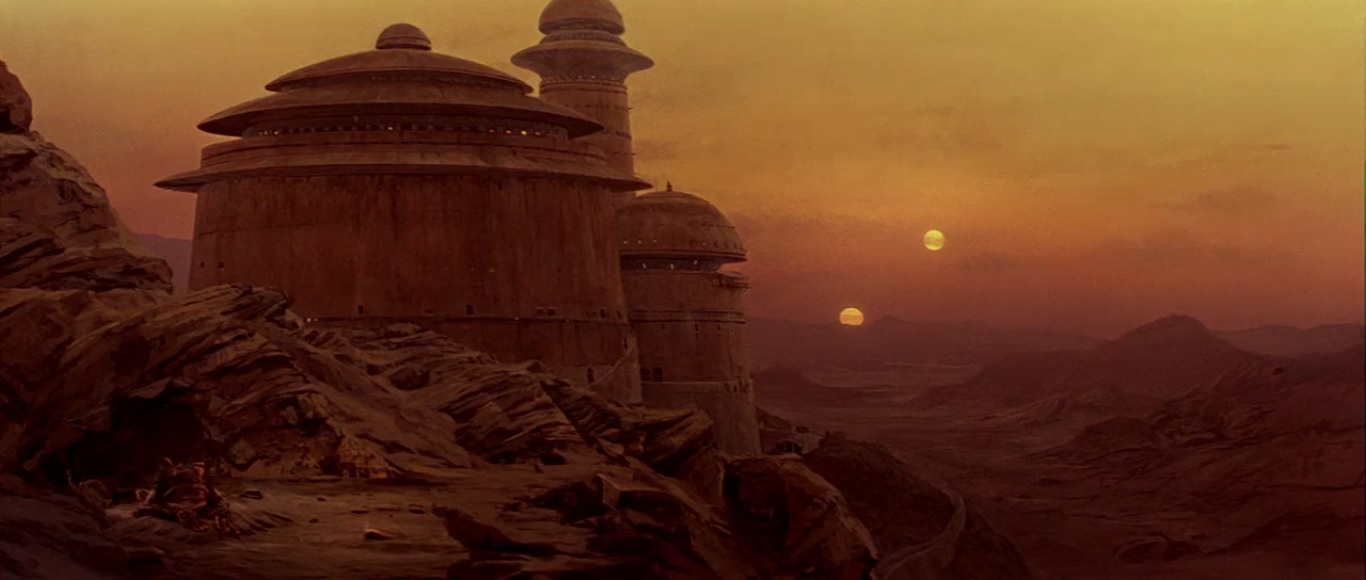
- As seen in Episode IV and Episode V, droids have personalities which are artificial, but nonetheless are an emergent property formed out of
the combination of their programmed nature with their life-experience. Droids therefore exhibit 'emotions' which are the result of their
personality from which a droid's mind forms conclusions which in turn form their likes and dislikes, preferences, and priorities. This leads
them to have simulated emotional responses, which even manifest as a kind of nervous droid energy when others they care about are
in jeopardy, including themselves. Droid anxiety is artificial, but is as real to them as to organic beings, and arises in both kinds of beings
from the same mental processes. C-3PO has so much of this droid anxiety about Jabba's Palace that he actively attempts to cut
the mission short, and makes arguments to R2 about how leaving or going back to Luke would be the proper protocol.
Main Article: Droid Intelligence
- Bib Fortuna is Jabba the Hutt's majordomo who tries unsuccessfully to get Luke's message out of R2 rather than give him an audience with Jabba. As seen in
Episode I he has been Jabba's top lieutenant since at least 7945 (32 BBY), which is set 36 years earlier. This film was Jabba's first appearance on screen
despite being repeatedly referenced in the first two SW films, as his appearance in Episode IV was a deleted scene until it was finished and added
to the Special Edition. Jabba's earliest appearance chronologically was also in Episode I, and he ruled Tatooine and dominated the Hutt Cartel from
before that year until his death during this film. Jabba was well-known in criminal circles, in the eastern regions of the Outer Rim, and historically in
political circles, however that may not be as much the case in the Imperial era due to the diminished sovereignty of Hutt Space and their domains.
- Bib responds to Luke's recorded message by advising Jabba that "he's no Jedi", something Jabba seems to agree with in theory, which the two are most
likely basing on the fact that he is very young and that Jedi have become exceedingly rare. Nevertheless, the two older individuals certainly know
what a Jedi is and enough about a what to expect in a Jedi to dismiss Luke as an unlikely candidate to be one. Despite being an illegal religion and
almost legendary to many in the galaxy even when they were in power, the Jedi were famous and extremely important for over 20,000 years.
It would take several generations to erode that kind of notoriety even with a systematic attempt to erase the knowledge from public consciousness.
Main Article: Awareness of the Jedi and the Sith
- Droids can be tortured, if they are intelligent and complex enough to comprehend fear over themselves, as well as possessing something like a nervous
system which is the wiring for power, malfunction detection, and limb functionality which runs through a droid. While it might not 'feel' anything like
pain does to an organic being, certain kinds of damage cause reactions which bring droids unpleasant feedback and fear for their existence.
Main Article: Droid Intelligence
- Jabba has a Twi'lek slave kept on a chain who he feeds to his rancor seemingly because he was bored. She was replaced shortly after by Leia, a Human,
so there was no reason to believe that Twi'leks were especially prone to being slaves, especially since Bib Fortuna was seen to be a ranking person
in Jabba's organization. Nevertheless, her appearance in this film created an association in the mind of SW fans between Twi'leks and slavery,
something which was elaborated upon in legendary material, and eventually made part of canon. The most likely reason there are two Twi'leks
here is that the Twi'lek homeworld of Ryloth is relatively near to Tatooine, so they are amongst the species that are more likely to be seen on other
planets in this region. Based on their expanded history, a great many Twi'leks were sold into slavery by the Separatist Alliance during the Clone Wars.
Twi'lek resistance to the Empire resulted in extreme oppression on Ryloth, as well as forced-labor and even more Twi'leks being sold as slaves.
- Leia is posing as a bounty hunter who is apparently a member of the Ubese species, based on their characteristic helmets which allow them to breathe
on planets suitable for oxygen-breathers. This is based entirely on supplementary material, as they have not been seen in any actual canon other
than Leia's impersonation of one in this film. Portraying a member of this race allows her to refuse any request to take off her helmet.
- Episode V revealed that Boba Fett was well-known for disintegrating targets, and also that he was quite good at bounty hunting. When Leia first arrives,
he is flirting with the showgirls, as he clearly likes the ladies. He is nevertheless paying enough attention to the tone of Jabba's conversation to take
a more strategic position for providing security when Jabba starts to haggle with the bounty hunter. His show of respect for Leia's profitable gamble
with the thermal detonator shows that he is a man with some code of honor, or at the very least professional respect for others with bounty hunting
and mercenary skills. Despite his prowess in bounty hunting and tactful maneuvering, when confronted with unexpected combat he resorts to a blunt
force attack against an opponent of unknown abilities, leaving him in a situation which results in his total defeat, not very tactful at all. Despite his abilities
and military technology, he died unceremoniously when his jetpack was damaged in a melee and malfunctioned, leading him to endure the fate to which he
had been helping to sentence Han, Luke, and Chewie. That was absolutely the intent of this film, to show Boba Fett meet his just end, however this has
been retconned in the disney canon in The Mandalorian and The Book of Boba Fett out of a desire to resurrect a well-liked Lucas-era character.
Apparently, Boba Fett not only survived and escaped the sarlacc, but also aged considerably and gained some weight while in the belly of the beast.

How long can Han stay frozen in carbonite and not be also dead? Carbon-freezing units are always shown to have some
sort of instrumentation which is monitoring, and perhaps maintaining the status of the object in stasis. Exactly how it is
biologically possible for a lifeform to remain alive in such a condition isn't often addressed in non-canon material, but
in a civilization advanced enough to have a substance like bacta, it is certainly imaginable that there is some chemical,
technological, or combined method which preserves living matter in such a state. In Episode V it is pointed out that
the freezing process could kill Han, however after it is successful there is no mention of how long he could still be alive
in that state. Leia tells Han that he has "hibernation sickness" which has given him temporary blindness, suggesting this
is a common occurrence when someone has been frozen for any extended period. It is difficult enough to understand
how the cells of a body could have survived months in that state, and even harder to imagine that a frozen person
wouldn't eventually die anyway, not that Jabba cares. However, since we don't know how this theoretically works, we
can't speculate how long someone could live in this state. Based on this film, it is at least months, maybe up to a year.
- Luke's entrance to Jabba's palace demonstrates that Luke has grown not only more powerful, but also has progressed towards each of his possible
destinies, those of becoming a noble Jedi, or an agent of the dark side like his father. Much like Anakin, Luke is simultaneously closer to both
goals when they reach a crisis point where the choices they make will dictate which aspect of the Force will dominate their future. In Episode I
and Episode IV, Skywalker is essentially a good person, wears white, and chooses to become a Jedi partly for personal reasons. In Episode II
and Episode V, Skywalker discovers that things are more complicated than black and white, wears darker colors, in Luke's case grey and tan,
in Anakin's brown, and is given reasons to question their future as a Jedi. In Episode III and Episode VI, Skywalker has grown in both of his
possible destinies, wears black suggesting their approach to the dark side, and begins the narrative having not yet fully committed to a path as
far as the Force is concerned. Each chooses the path will get them what they desire most, in Luke's case, that is to save his father or die trying.
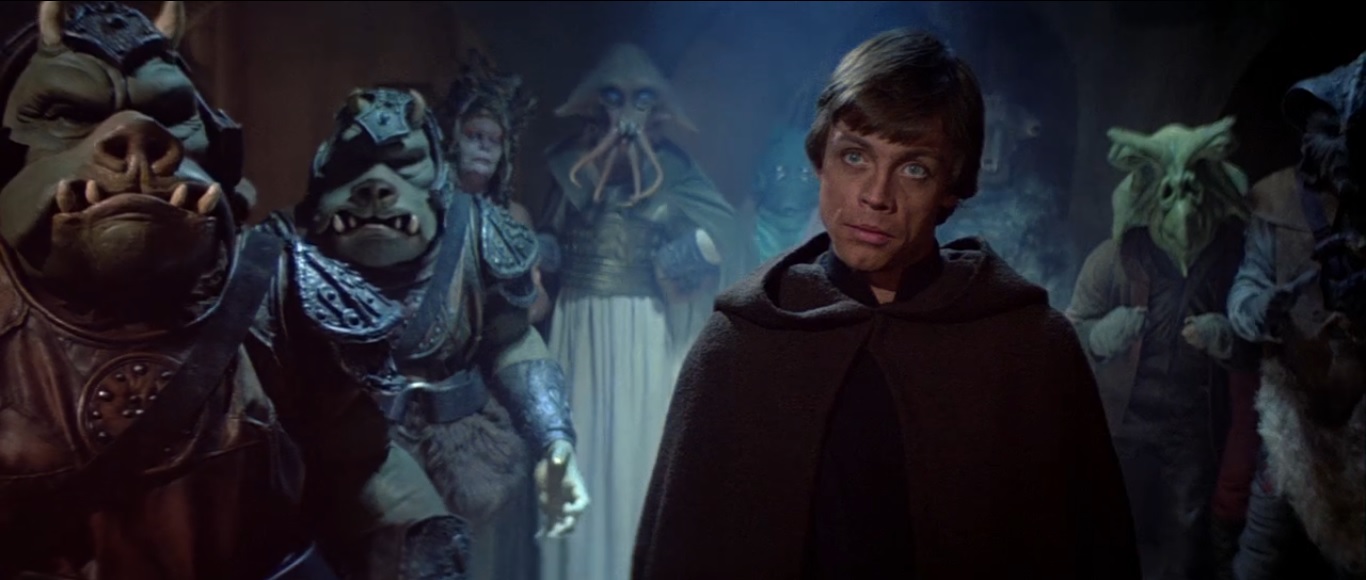
- Luke's Jedi mind trick works well on Bib Fortuna, leading Jabba to call him a "weak-minded fool", which as Obi-Wan pointed out in Episode IV is who
the mind trick is most effective against. Jabba refers to this as "an old Jedi mind trick", suggesting that Jabba is not only aware of the tactic but
also knows of its antiquity. In other words, this ability of Jedi is legendary. Having seen this demonstrated, Jabba seems to be aware that Luke
is indeed a Jedi, but is still dismissive of Luke as a "boy", and doesn't seem overly concerned about his ability to handle Jabba's gang.
It is unclear if Jabba is too strong-willed to be effected by the mind trick, or if Hutts are biologically resistant like the Toydarians.
Main Article: Awareness of the Jedi and the Sith
- Rancors are large, aggressive, reptile-like creatures, said in supplementary material to be aboriginal to the planet Dathomir. It is later seen in The Clone Wars
'Bounty Hunters' (S2E17) that rancors can also be found on Felucia, and perhaps other planets. It is unknown if this was a case of interplanetary
parallel evolution, or if wild Felucian rancors are the descendants of transplanted rancors from Dathomir.
Main Article: Planetology

Those who are eaten by the semi-animal, semi-plant sarlaac creature will be "slowly digested over a thousand years",
at least according to Jabba. Assuming this is at least partly true, the very same questions can be asked about this as
carbon freezing, particularly how is possible to still be alive for more than a few days in such a state? Considering
that this large creature flourishes in a desert environment, it must be like most desert-capable creatures which have
methods of preserving the resources which keep them alive. It is also not unusual for predatory plants and animals
to use enzymes or chemicals to keep creatures or tissues alive or preserved while they feed on them. The implication
seems to be that the sarlaac's stomach contains enzymes which keep the body healthy enough to parasitacally drain
some of the fruits of the body's labor, thus keeping it alive in a horrible situation perhaps well beyond its regular
lifespan. Legends and supplementary material have disregarded Jabba's words as bluster, and decided that sarlaacs
are actually more mundane and less interesting than that, and people die quickly in its stomach because the air is toxic.
- Some of the creators were concerned that fans would want to know where Luke's new lightsaber came from, so George Lucas explained on set
the symbolic and conceptual importance of Luke having built his own lightsaber, saying "the idea running throughout the whole trilogy is:
First he's given his father's sword, because his father lost it in the fight with Ben Kenobi. Ben cut his hand off and Vader fell into the volcano,
so Ben then pried the laser sword out of the hand and kept it for the son. So then what the father did was cut his son's hand and laser sword
off, and that was a way of severing the relationship between father and son. Not only did Luke lose his weapon and was 'castrated', but at
the same time his father split that relationship. Luke was carrying his sword for his father. Now he is not doing that anymore. In this one,
he's build his own laser sword, he is his own man, he is not a son anymore, he is an equal." The fact that Luke constructed it is mentioned
later by Vader, who underscores how it represents Luke's status as a fully realized Jedi, a true opponent to Vader.

- A single Jedi Knight is more powerful than an entire gang, particularly when that Jedi had the opportunity to plan his moves in advance.
This was the first demonstration of the battlefield worth of a Jedi warrior, which was shown more fully in the prequel trilogy. A Jedi's
ability to use the Force to predict what is about to happen makes it possible to engage multiple adversaries at once, their lightsabers
are a single tool which acts as both weapon and shield, and can even reflect their opponents' fire back at their own forces. This does
not mean that victory is a certainty for the Jedi, but it does make it difficult to defeat them simply by possessing greater numbers.

Has Luke been back to Dagobah since Episode V? According to all legendary material, including comic material
that disney-era Lucasfilm considers canon, Luke trained with Yoda for a few weeks, told Yoda he just had to go and
rescue his friends from Vader and that he would be back, but didn't return for about a year. Why would this be the case?
Hyperdrive speeds in this era allow one to cross the galaxy in a day's travel. It is possible Luke was too busy with planning
Han's rescue and Rebel affairs, but it seems to run contrary to his prior fixation on becoming a Jedi. Perhaps he spent
time reevaluating this goal in the light of new information, but by the time we see him in this film, he has advanced
considerably with the Force and in Jedi wisdom, the kind that comes from meditating through the Force and practicing
the Jedi arts. Luke was not ready to face Vader in Episode V, but he is ready now. If he was practicing and developing
on his own seriously enough to reach this stage, it would make more sense if Luke had made several return trips to
study with Yoda in the interim. Luke tells Leia "I have a promise to keep to an old friend" when referencing his upcoming
journey to Dagobah, seeming to suggest he hasn't been back since. When speaking to Yoda, Luke says that "I need your
help. I've come back to complete the training", to which Yoda replies, "No more training do you require. Already know
you that which you need." This statement is inconclusive, since it could make sense if Luke hadn't been back or if he had
been back several times. It does seem like Luke would have insisted upon knowing if Vader was really his father at his
first opportunity to speak with Yoda, so it seems it is most likely that he has not been back since.
- Palpatine has ruled the known galaxy for 23 years as Emperor, since 7958 (19 BBY), and has been the head of state on the galactic capital
of Coruscant for 36 years, since 7945 (32 BBY). Since he dissolved the Senate 4 years earlier in 7977 (0 BBY), Palpatine's already
oppressive rule has maximized its tyranny in response to increasing rebel activity throughout the galaxy.
- The Imperial Minsters who accompany Palpatine on board the Death Star are members of the Emperor's court, sometimes called the Imperial
Council. They are also sometimes referred to as Palpatine's Advisors. These are the highest ranking members of the Imperial executive branch
other than the Emperor, and they work directly with the Emperor to govern the galaxy. It is unlikely that the six Ministers who accompanied
Palpatine constitute the entirety of the Council, and indeed in later SW material additional Minsters were seen, however Greejatus, Aloo,
and Prestage were certainly amongst the most prominent figures in Palpatine's government. Although they have no speaking lines in this film,
Greejatus and Aloo are seen later conferring with Palpatine when Vader is summoned to receive his orders. Greejatus was first named in
the novelization of this film, and Aloo and Blista-Vanee were later given names in supplementary material. Sate Prestage was originally
a supporting character with brief dialogue in Episode V, but was dropped after script changes. Prestage and Dangor were identified by
Lucas-era Lucasfilm in 2003, back when supplementary material was always canon. Nevertheless, the identification of Ars Dangor has
been rejected by some fans, since the character of Dangor is very different in legendary material from the Minster here wearing
the tall green hat. The sixth advisor who accompanied Palpatine on the Death Star has not yet been identified.


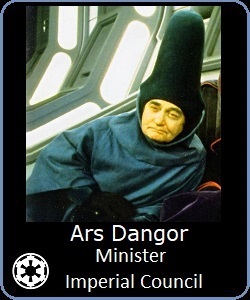
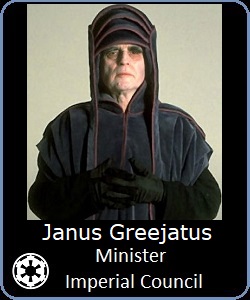

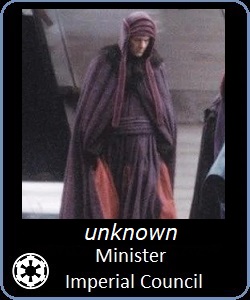
- Vader has apparently remained intent on finding Luke, and probably spent some of the beginning of this year continuing the search. Having been
taken away from that search for at least the mission to get the Death Star project back on track, the Emperor knows he will be eager to resume
looking for their new enemy. This dialogue also suggests it is possible that some unseen days have gone by since Vader arrived on the Death Star
and the droids arrived at Jabba's palace. Palpatine seems aware that Vader's feelings about this matter are at least a bit conflicted.
- The Emperor discusses bringing Luke to the dark side of the Force with Vader within earshot of Moff Jerjerrod, his Ministers, and a few other officers.
It is clear that Palpatine isn't concerned at this point about anyone knowing that he is a Sith Lord, particularly his most loyal agents. Nevertheless,
Moff Tarkin didn't seem particularly wise to the situation in Episode IV, where he called Vader the last of the Jedi religion. In deleted scenes
from that film, leading Imperial officers openly discuss with disdain the inclusion of a "Sith Lord sent by the Emperor", a scorn which they would
likely not have been so vocal about if they were aware that Palpatine was a part of that religion. Nevertheless, Vader and the Imperial Ministers
are definitely aware of who he is and what he is about, as they are complicit in his philosophy and goals. Moff Jerjerrod and whatever officers
were in earshot are probably of no concern to Sidious, as they will obey the power of the Emperor regardless of whether or not he is a Sith.
Most people in the galaxy are unlikely to have a strong opinion against the Sith unless they are particularly knowledgeable about such things.
This is largely because the Sith, unlike the Jedi, are now historical to the point of mythological and were unseen in public for a millennium.
Main Article: Awareness of the Jedi and the Sith
- As George Lucas explained, "one of the issues in all of this is that bad guys think they're good, and Lord Sidious thinks he's bringing peace to
the galaxy, because there's so much corruption and confusion and chaos going on, and that now he's going to be able to straighten
everything out, which may be true, but the price the galaxy's going to have to pay for it is way too much." Lucas was in fact discussing
Palpatine at the time of Episode III set 23 years earlier, but in principle this probably hasn't changed much. It is true that using
the dark side twists a person and skews their thinking, as Lucas describes it is like the effects of a strong and addictive drug. Prolonged
exposure theoretically increases its effects, and Palpatine has been using the dark side for more than four decades. Nevertheless, the Sith
do not believe themselves to be devoted to evil, or purposely sadistic. While they have little concern about the ethics of what they are
doing, and have no problem killing or destroying anything that is in their way, they believe they have a right and even a duty from the Force
to use the gifts they were given to make the world better according to their ideals. The Sith believe in the strong and the capable ruling
over the weak and the powerless. They believe that order builds strength, and that heartless competition proves who and what is better.
Sidious therefore believes he is making the galaxy better, and those that oppose him are agents of disorder who stand in the way of
progress. This philosophy doesn't desire to burn the galaxy to the ground whenever possible, but rather to cleanse and perfect
galactic society around Sith ideals and values. Palpatine believes he is morally superior to the Jedi and others with different values.
Main Article: Darth Sidious and The Plan
- Luke's X-Wing is hovering stationary just above the ground while Luke is in Yoda's house and R2 is on the ground watching. It does so using
devices known as repulsors, also known as inertial compensators, which are the basis of most advanced technology in SW. These devices
allow speeders to hover above the ground, Cloud City to hang in the sky, ships which aren't even aerodynamic to take off and leave
an atmosphere without rockets, and most important of all, allow ships of all sizes to fly at incredible speeds without g-forces crushing
the passengers within. Since the cockpit canopy is closed, Luke presumably has some kind of remote to get back in. Strangely,
in the very next shot, the ship has been landed and R2 is making repairs, meant to emphasize that Luke didn't crash this time.
- Yoda tells Luke that he is 900 years old, assumed to be a rounded number. This means that Yoda was born around the year 7081 (896 BBY).
In Episode V, Yoda tells Luke that he has trained Jedi for 800 years, which means he was promoted to the rank of Jedi Knight around
the year 7180 (797 BBY). Yoda's mysterious species certainly lives longer and has a different life-cycle than Humans, and this suggests
that 100-year-old Yoda was comparably as mature as a Human in their twenties. As such, Yoda is more than 250 years old in 'Human-years'
at the time of his death, which means his species can live twice as much of their life after reaching maturity as Humans can.
- Yoda says that it is "unexpected and unfortunate" that Vader told Luke he was his father. Yoda likely believes, somewhat dogmatically, that those
who embrace the dark side are twisted beyond hope of salvation, and therefore Vader would want nothing to do with anything from his Jedi
past. It is helpful for the Jedi to see it this way, as it helps with detachment from the task they must undertake to confront the Sith. Nevertheless,
the Jedi teach that one is forever lost to the dark side because it is so difficult to break the addiction that most never can. The Order has been
teaching this for so long that these Jedi accept this, even though most have no direct evidence to confirm or deny this. As seen in this film,
no matter how evil someone has become, or what horrible things they have done, anyone who ever had goodness in their heart can reconnect
with that, if they have the will. Yoda emphasizes that what is unfortunate about this is that Luke rushed to face him when he was ill-equipped
to defeat him in combat, and not ready emotionally or in terms of Jedi wisdom to handle this revelation. At the same time, Republic-era films
and shows show that the Jedi believe in withholding information until they deem someone ready for it, and that they are in practice quite
deceptive to many who trust them, including their own, and at the very least only share what they consider to be need-to-know information.
- A Jedi's strength flows from the Force, but in using the Force, a Jedi must always beware of anger, fear, aggression, as they are manifestations
of the dark side. As just discussed above, it is possible to break the addiction of the dark side, however the Jedi are mostly correct to warn
that once someone starts down the dark path, it will forever dominate their destiny. Even those who return from the darkness find that
the dark side still dominates their destiny, despite them no longer reaping benefits from it. Yoda also warns Luke, "Do not underestimate
the powers of the Emperor, or suffer your father's fate, you will." Like Luke, Anakin was fully aware that Sidious was a powerful Sith during
the confrontation which led to Anakin's fall. Anakin had arrived hoping to prevent Sidious' death, believing that he could be controlled after
being captured, and that Anakin could still learn his Sith secrets. After joining the Sith, he soon told Padme that he was more powerful than
Sidious and could overthrow him. Anakin's overconfidence in his abilities and his underestimation of Sidious' led him to two-decades of
servitude, which is exactly what Yoda fears will happen to Luke if he falters in his commitment to the Jedi path.
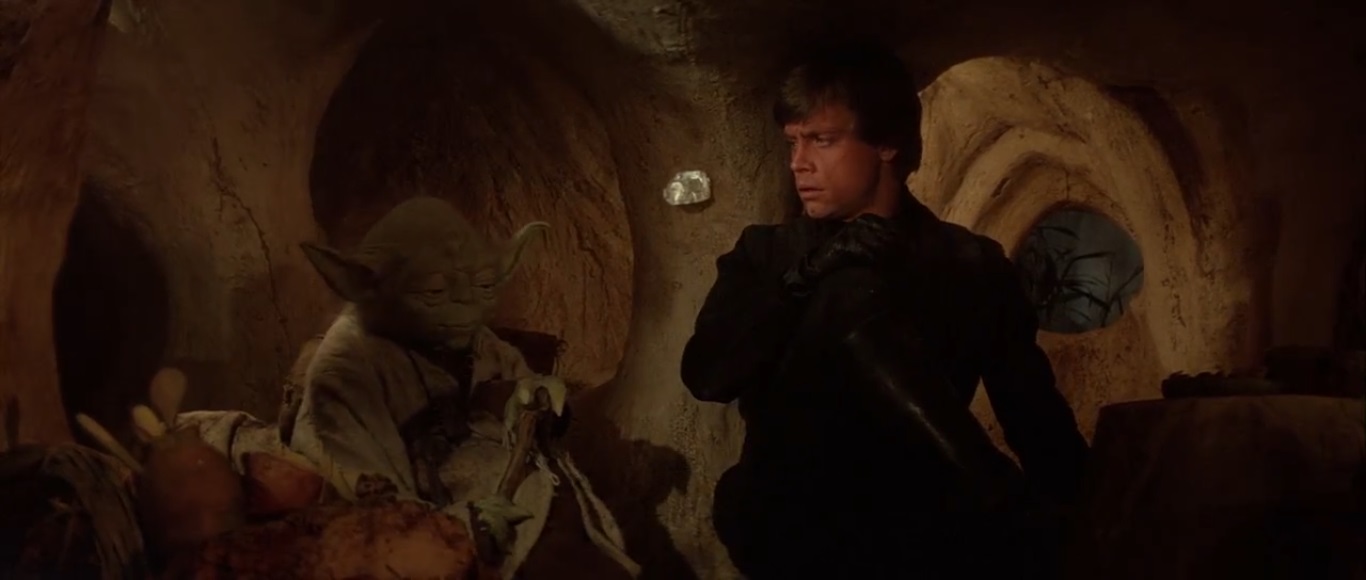
- Yoda tells Luke, "When gone am I, the last of the Jedi will you be." For all intents and purposes, this is true, although not literally, since there are
undoubtedly more than a few Jedi in the galaxy. Hundreds survived Order 66, and while the greater part of those Jedi were killed or passed
away sometime in the last two decades, according to George Lucas several Jedi from the Republic era were still alive as much as twenty years
after this film. In the meantime, more than a few Jedi survivors would have passed on their ancient religion to new Force-sensitive students
who were trained in hiding or in secret. At this point, all other Jedi are operating in the galaxy in secret, affecting small change and looking
to the future, much as the Sith had done in the thousand years after their defeat by the Jedi. Both Republic-era survivors and new Jedi
students have been seen in non-Lucas canon shows, and no doubt there are a surprising number of others who have not been seen.
At the same time, Luke represents the last of the Jedi of old. No new students would have had the benefit of being trained by members
of the High Council like Yoda and Obi-Wan, and while Luke himself never lived in the Republic-era, he is the direct inheritor of the Order
by virtue of Yoda passing down his teachings and instructions to Luke. Other Jedi may have different ideas about the future, the idea of
rebuilding the Jedi Order, and what direction to take, but Luke has his instructions directly from Yoda: "Pass on what you have learned."
- Ability to connect to the Force is often, if not always, passed down to children, although to a somewhat diminished degree unless both parents
are highly-sensitive to the Force. This is later explained in Episode I to be a measurable quality, which determines one's natural
aptitude with the Force. Training using the Force and knowledge of the Force gained by connecting with it greatly effects any one
Force user's power with the Force, however a stronger natural connection to the Force makes such progress far easier. Additionally,
being Force-sensitive enough to actually wield the Force is extremely rare in the galaxy in general, with the odds of any one child being
a Force wielder somewhere around 20,000 to trillions. The Jedi seemed in the past pleased to maintain this ratio by discouraging their
members from having children. The Jedi do not wish to see powerful and entitled families gain power due to their connection to the Force,
not to mention the familial attachments which will constantly cloud their path and through attachment lead many to fall to the dark side.
In Episode I we learn that Anakin's immaculate conception by the Force has endowed him with the highest connection to the Force
ever recorded by the Jedi. Luke and Leia have therefore inherited much of this natural connection, and are unusually strong in the Force.
- Yoda succeeds in Qui-Gon's spiritual path, just as Obi-Wan did, and transforms into the Force at the moment of his death. Qui-Gon's spiritual
achievement in preserving his individuality after death is what allows the Jedi Order to be preserved after its death. Qui-Gon proposed
defeating the Sith with spiritual enlightenment rather than large numbers of Jedi warriors and military forces. By learning to manifest
a consciousness after death, and to commune with the living, Obi-Wan and Yoda can continue to teach and aid Jedi, becoming essentially
undefeatable. This trilogy ends with the culmination of the unexpected Jedi plan the Sith could not see unto their defeat, just as
the prequel trilogy would later end with the Sith enacting the inverse against the Jedi.
- Luke confronts Obi-Wan about lying to him and saying that "Vader betrayed and murdered" his father Anakin. Obi-Wan's response is that
"what I have told you was true, from a certain point of view" and "you're going to find that many of the truths we cling to depend greatly
on our own point of view." This is very much in keeping with Jedi practice, but this practice of spinning the truth shouldn't necessarily
be viewed as manipulation. The Jedi have the wisdom to know that truth is to a certain extent in the eye of the beholder, and the Jedi
make a practice of telling people what they feel they are ready to hear. While this can be considered self-serving and manipulative, and
many may see it this way, this is honestly the way the Jedi see it, and the Sith. Obi-Wan explains that Anakin was seduced by the dark side
of the Force and "ceased to be Anakin Skywalker and became Darth Vader. When that happened, the good man who was your father
was destroyed." This is what the Sith teach to encourage their acolytes and apprentices from wavering from the Sith path, and what
the Jedi teach their students to encourage them to avoid the dark side, and also to enable them to confront former friends if they have
gone over to the dark side. Obi-Wan tells Luke that Vader "is more machine now than man. Twisted and evil." This is certainly correct,
and Obi-Wan has every reason to believe there is no hope of saving Anakin, however Luke and Anakin's actions in this film show that
this assertion of the Jedi and the Sith isn't concrete, and that the good man who was Anakin was never truly lost.
- Obi-Wan tells Luke, "Anakin was a good friend. When I first knew him, your father was already a great pilot. But I was amazed how strongly
the Force was with him." This was 36 years earlier in 7945 (32 BBY), as seen in Episode I, where Anakin was seen to have been the only
Human known who was capable of pod-racing and to have had an unnatural connection to the Force, which was noticed by Obi-Wan's
master Qui-Gon Jinn." Obi-Wan also says that "I took it upon myself to train him as a Jedi. I thought that I could instruct him just as well
as Yoda." As also seen in Episode I, it was actually Qui-Gon who took it upon himself to train Anakin, and who though he could
instruct him just as well as Yoda, and Obi-Wan only took up this mantle to honor a promise to his beloved master, who was killed.
- As seen in Episode III, Luke and Leia were hidden from the Emperor and Vader at birth, and split up in order to keep them safe from the Sith.
Obi-Wan says that "the Emperor knew, as I did, if Anakin were to have any offspring, they would be a threat to him." The unusual ability
with the Force has always made the Skywalkers a threat to Sidious' plans, however he was able to gain influence over Anakin,
eventually turning him from a threat into an asset. Luke and Leia being raised outside of his control proved to be his downfall.
- The Rebel fleet that has been assembled constitutes the bulk of naval forces which the Alliance can muster at this point in the war, due to the nature
and importance of the target they plan to hit. This fleet is probably the most powerful combined fleet the Rebels had assembled at any point
in the war so far, chiefly due to the inclusion of the Mon Calamari fleet. The Mon Calamari have large and powerful star cruisers which are
capable of standing up in a fight with large enemy warships. In the original film there appeared to only be two, namely the command ship
Home One which is an MC80A-class heavy cruiser, and one MC80 Liberty-class heavy cruiser. These two can be seen in the staging area
where the fleet has amassed, and at the beginning of the Battle of Endor when the first Rebel ships spin out of hyperspace. Ships added to
later scenes by the Special Edition must have been trailing and arrived after the shot cut away, since there are dozens more large Rebel
ships including several MC80-class and at least five other MC80A-class ships in addition to Home One. The staging area was located near
Sullust, according to reports that Vader and the Emperor discuss. Sullust is located in the Western Reaches of the Outer Rim, and is far
enough from Endor not to be noticed, but near to the charted routes which the Rebels must take to reach Endor. Sullust is the homeworld
of the Sullustans, a race of humanoids to which Nien Nunb belongs, who is the Rebel who co-pilots the Falcon with Lando.
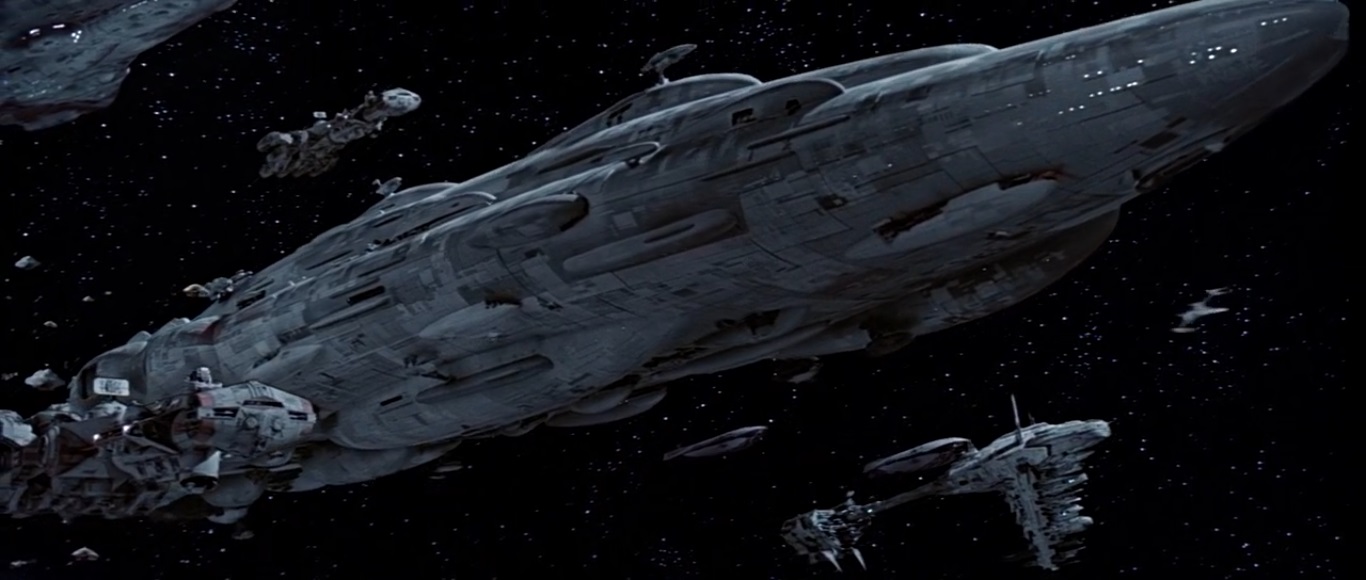
- Lando suggests to Han he must have been made a General because of his "little maneuver at the Battle of Taanab." According to legendary and
subsequent supplementary material, the Battle of Taanab was a battle that took place in 7977 (0 ABY) between the defense fleet of the planet
Taanab in the Inner Rim, and a significant pirate fleet which was attempting to raid the planet. Apparently, Lando was operating out of
Taanab at the time, and he wound up not only taking part in the battle but also leading the defense fleet.
- The Rebel Alliance has new uniforms since they were last seen about a year earlier. As discussed above, nearly every Imperial insignia in this film
is wrong due to most officers being given the same insignia. The Rebel insignia are also suspect, with some claiming the domino-style insignia
were meant to be included, but were left off. This seems less likely, since the Rebels do have rank insignia, which are distinct ornamentation
on the collar, and the color of the collar seems to indicate which branch of the military the officer serves in. The mysterious device and/or
insignia worn on the breast are once again present, different from those seen in Episode V, but similarly don't seem to indicate rank
unless part of a nonsensical system. Only a handful of officers in dress uniform are shown, so the full range of insignia are not known.
Main Article: Ranks and Rank Insignia
- Senator Mon Mothma of Chandrila is the leader of the Rebel Alliance. Her first appearance here is her last appearance chronologically, however
she is seen in other material to have been a Senator since the Republic era, having been elected in 7945 (32 BBY). Her earliest appearance
chronologically was in The Clone Wars where she was seen in fourteen episodes. She was a background character in Episode III since
her two scenes with dialogue were deleted. She also appears in Andor and Rebels.
- Admiral Gial Ackbar is the current commander of the Mon Calamari fleet, and is the commander of the Rebel fleet which has assembled to assault
Endor. This was his first appearance on screen, but his earliest appearance chronologically was in The Clone Wars 'Water War' (S4E1) and
the two following episodes which were part of the same story, set 24 years earlier in 7957 (20 BBY).
- The Rebel's learned of Palpatine's visit to the Death Star from their Bothan spies. The Bothans are a mammalian species with fur, pointy ears, and
an elongated snout. They have not been officially seen in canon, although there is almost certainly one seen in Droids 'Escape Into Terror' (E2)
as a background character. Their homeworld is the planet Bothawui which is located at the heart of a region known as Bothan Space. Despite
decades of legendary material about the Bothans, disney Lucasfilm wishes to be ambiguous about whether they are a separate race or simply
Humans from Bothawui, in case they decide to do some story about the Bothan spies and don't want their main characters to be furry aliens.
- The shield generator located on the forest moon of Endor is capable of generating an energy shield which is projected like a balloon around the area
where the shield and generator are, up through the atmosphere and then expanding to encompass the Death Star. This kind of transparent
energy shield seems similar to the shield being used by the Rebels on Hoth, as it is not safe to fly through it when active. It is generated from
a very large dish-shaped array which is wired directly into a power generation station. It is possible that a small number of these arrays working
in concert could shield something as large as a planet or planetary moon such as Endor. Despite the huge size of the array and the immense
power output likely being generated by the power station, it is still an impressively strong shield to be so large and still impenetrable in orbit.
Main Article: Shields, Deflectors, and Ray Shields
- Han tells Chewie he doesn't think the Empire had Wookiees in mind when they designed their ships. It is true that Cygnus Spaceworks and Sienar
Systems build ships with Humans and other similarly-sized races in mind, and don't necessarily design extra headroom for taller species.
This isn't necessarily a good example of the Empire's overt racism, however the Human-centered nature of the Empire is most clear in this
film compared to the first two films in this trilogy, as the Rebels are shown to be a far more diverse group of the galaxy's citizens. There was
a great deal of residual colonial racism in the Republic, however it wasn't always exclusive to Humans, as many sophisticated and advanced
races from the Core who were not Humans sometimes looked down on 'primitive' races. The transition to Empire recontextualized this
racist undercurrent as part of its political philosophy, making the Empire actively hostile to non-Humans who resisted Human dominance.
- The Emperor's Tower on the Death Star is meant to serve as his home away from home, and ultimately as his new permanent residence. Sitting atop
the 'northern' pole of the station, its architecture resembles the spires of the Jedi Temple on Courscant, which according to supplementary
material now serves as the Imperial palace and Palpatine's personal residence. The tower is chiefly a huge elevator shaft with a single floor
near the top. The layout of this floor, including the two compartments not seen in this film, is reminiscent of the Chancellor's Office in
the Senate office building which was Palpatine's in Episode III. The throne room and the map room are seen in the film. The other
two compartments are described in supplementary material as his residential quarters and a private docking ring. The entire area around
the tower is heavily shielded, with a great deal of redundancy, and numerous defense towers surround the tower including a dense
concentration of XX-9 heavy turbolaser batteries, making this tower the least vulnerable point on the Death Star.
Main Article: Darth Sidious and The Plan
- Fleet Admiral Firmus Piett is still the commander of Vader's flagship the Executor, the position he was abruptly promoted to in Episode V.
His executive officer is Commander Gherant, who is later in the film surprised they aren't going to attack when Admiral Piett explains he has
his orders directly from the Emperor. He is commanding a significantly larger fleet than when he was last seen, as the fleet protecting
the Death Star construction contains over 30 star destroyers. While Commander Gherant's insignia is accidentally correct, Admiral Piett
is wearing a woefully incorrect insignia, due to the above mentioned costuming debacle which gave most Imperial officers the same insignia.
Main Article: Ranks and Rank Insignia
- Vader senses Luke on the passing shuttle through the Force, an ability first demonstrated at the end of Episode V. Despite his power with
the Force and the great vision it gives him, Sidious does not see Luke coming in a bit of foreshadowing to the end of this film. This is later
shown to be a reversal of how the Jedi didn't see Anakin coming just before their fall from power in Episode III. As this illustrates,
the ability to sense another person, even one who is quite noticeable in the Force, is not like picking something up on a radar screen.
It is neither certain a presence will be sensed at all nor equally noticeable for every Force wielder. As is much SW material, a personal
connection to another person makes them far more noticeable to the person they have a connection with, to a degree that people are
even identifyable by their presence in the Force, as seen in Episode IV, and can be communicated to at distance, as seen in Episode V.
- The Forest Moon of Endor is a terrestrial world in orbit of the gas giant planet Endor (also called Tana), located in the Moddell Sector, beyond
the Western Reaches in the Outer Rim. The moon itself is usually called Endor and is also referred to as the Sanctuary Moon. Endor is
the homeworld of the Ewoks and the Yuzzums. In the animated series Ewoks and its associated live-action films, Endor is also shown
to be the homeworld of the Wisties and the Gorax, which could also be considered to be canon species. While Endor is rightly notable for
its heavily forested landscape, the moon also features grasslands, mountains, small seas, and lakes. Endor is located in one of the more
remote and unfrequented regions of known space, situated in an area that is not significantly populated by races from the Core.
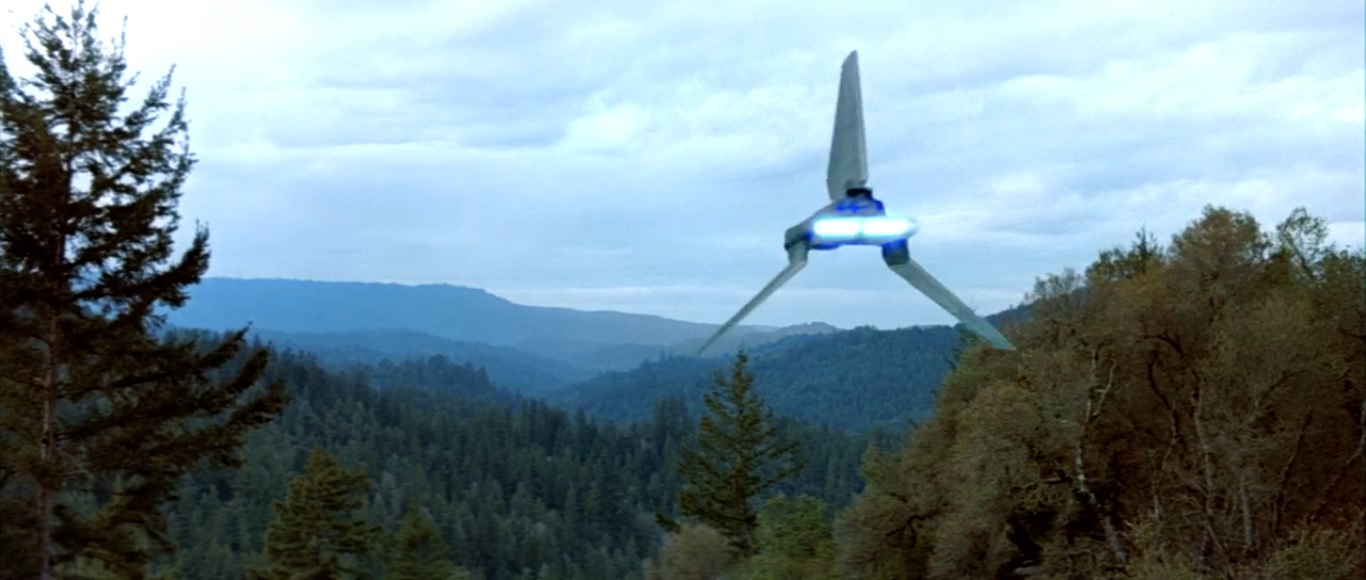

Why did they bring C-3P0 on a stealthy special forces mission without painting him or giving him one of the camouflage
ponchos other Rebels like Luke and Leia are wearing? While this might have effected how the Ewoks perceived him, and
indeed altered the course of the story, the question is why the Rebels didn't think this was going to be a problem.
There's little point in anyone wearing camouflage if one of the team is entirely shiny and gold. The fact that he is later
able to get near the shield generator bunker without being noticed is a poor reflection on the Emperor's elite legion.
- Like many large starships and installations, speeder bike have communications jammers, which are presumably smaller and have a more localized
effect, but nonetheless can interfere with com-signals within their range. The jamming equipment must be relatively compact.
- The Ewoks are a race of small, ursine creatures native to the forest moon of Endor, one of either two or four sentient species native to the moon,
depending on what material is considered canon. The animated series Ewoks and the related live-action films were created by Lucas,
however they don't figure in at all with the timeline of the rest of SW material, and some of what goes on is probably not canonical, but
not certainly. They are a clever and industrious society, but technologically are still in the stone age. Lucas had originally intended that
Wookiees were featured as the 'primitive' race which overthrew the Emperor, but decided they were too technologically adept to qualify
for the role. The Ewoks are a spiritual people who revere nature and are fiercely protective of the forest on Endor.

After having sensed that Luke has landed on Endor, Vader goes to see the Emperor. Immediately before the scene where
Vader informs the Emperor, he was to have been stopped at the entrance to the elevator leading to the Emperor's tower
by Moff Jerjerrod, who tells Vader that he does not have permission to enter. Vader chokes him, only to have Jerjerrod
gaspingly explain that the Emperor has commanded it, leading Vader to desist. This demonstrates that Vader isn't afraid
of anyone in authority except the Emperor, and clearly won't take orders from anyone else. The fact that Vader needs to
schedule an appointment or be summoned to see Palpatine suggests how isolated he has been kept from the inner circle.
- Sidious is irritated that Vader did not remain on the command ship as instructed, and is clearly even more disturbed by this behavior when he learns
that Vader has sensed Luke when he has not. If the dark side did not readily show Luke to Sidious, it suggests that Vader may be using feelings
that are dangerous to the Sith. More importantly, it suggests that there is a bond between the two Skywalkers which is potentially dangerous
to him. As always, Sidious intends to use his knowledge of the threat to turn it into a weapon in his arsenal, now planning to use Luke's feelings
for his father to manipulate him into joining the Sith, the way he used Anakin's feelings about Luke's mother. Sidious has also foreseen that Luke
will come to Vader willingly, which is how he will gain the opportunity to turn him to dark side. His vision allowed him to successfully navigate
a tenuous and potentially life-threatening moment in Episode III in a manner which would succeed in bringing Anakin to the dark side.
He has now seen the same glimpses about Luke, but this time the Force is not with him, and didn't reveal enough to allow him to evade defeat.
- C-3PO is regarded as "some sort of god" by the spiritual, nature-loving Ewoks, seemingly because he is entirely gold colored. They also regard him
highly because he understands and speaks their language. Their reverence of him is understandable for a stone age culture, however they
do not seem to fear him, as they aren't keen to take his instructions. Luke takes of advantage of their belief in magic, as even many people
from technological civilizations are shown to regard Jedi powers as magic or wizardry. Jedi use their powers to manipulate those who are
superstitious or easily impressed, when the situation calls for it and meets with their ethical concerns. Luke doesn't use his power with
the Force to convince the Ewoks that he is a god to be feared, or act out of greed to gain power over them. On the contrary, he gives
C-3PO the credit, and only puts on this performance to save himself and his friends from being cooked alive for no good reason.

Why did the Ewoks make Leia a dress? It is obvious that they like her and trust her after she befriended Wicket, and
while it is strange that they quickly produced a Human-sized garment for her, it at least seems like something they
might do. The real question is, why is she wearing it? More to the point, why is she wasting time here when she is
on a mission critical to this all important Rebel action? It is later in the same day, probably only hours later at most.
What exactly was her motivation for not only staying here but changing out of her uniform into a dress? If she
is humoring them because she wishes to gain their help, this is not readily apparent. She doesn't seem to be their
prisoner exactly, she seems to be just lying low with the Ewoks. Her motivations and immediate plans are unclear.
- C-3PO tells the story of SW inside this SW film. This was introduced by George Lucas not only as an important story point, as his heroic tale inspires
the Ewoks to lend their arms and their lives to the Rebel struggle, but also to illustrate a larger theme originally intended to be built upon in other
trilogies. R2 is the 'narrator' of the story of SW, according to Lucas, and C-3PO is simply his translator. Their friendship means that even when
R2 was with Anakin and C-3PO was with Padme, C-3PO would later relate to R2 what had gone on since he is chatter-box. After having his
memory erased in Episode III, C-3PO is ill-equipped to relate his own story from the Clone Wars era, and while he is not shown telling
that here, it was ultimately planned that many decades later R2 would relate the entire story by means of C-3PO, which is where the SW
films themselves were to have been the stories they told. This was part of Lucas' older ideas for a four-trilogy, twelve-film story, and the idea
that the story of the Skywalkers was passed down to future generations by these droids was intended to be the culmination of these films
which use classic mythological motifs. These stories were eventually to have passed from R2 into what was known as the Journal of the Whills,
with the idea that the opening crawl to each film was the opening paragraph to each of these myths. Thus, Lucas was not only intending to
explore narrative and revive mythological storytelling, but within his new myths to also explore how myths emerge in the first place.

- Leia never knew her mother, who is seen in Episode III to die after giving birth to her and Luke, but Leia 'remembers' her from images in her mind.
These "images" Leia sees through the Force, as she never knew her mother in person, but is so Force-sensitive that she was connected even
as a child. The Force also sometimes shows people "long gone", as Yoda teaches in Episode V, so the Force is likely to show a vision of Padme
to someone deeply connected to her. She calls her memory "just...images, really. Feelings", which is exactly what most visions in the Force are
based on other SW material. Nothing Leia says implies that she knew her mother from early childhood, only that she remembers her from
some strange, indistinct memories of her being beautiful but sad, precisely as she was later shown to have been at her death.
- Colonel Igar is the commander of one of the two regiments of Tempest Force, and is the officer who hands over Luke to Vader and requests to do
a further sweep for Rebels. Tempest Force is the name of a legion of the Imperial Army which the Emperor describes as amongst his best.
Legions were divided into four regiments during the Clone Wars, and that may still be the case, however only two different regiments are
seen in the film. Colonel Igar's troops are guarding the perimeter and conducting recon in the forest. Colonel Dyer, seen later in the film,
is the commander of the regiment protecting the shield generator bunker. Igar is called "Commander" by Vader, just like many Imperial
officers, which as usual is a reference to his position rather than his rank. Nevertheless, he is usually incorrectly identified in supplementary
material as Commander Igar, despite the fact that no such rank exists in the Army. Despite the massive costuming error which gave nearly
every Imperial officer the same insignia, Igar is in fact wearing one of the two correct insignia for an Imperial Army Colonel. Colonel Dyer,
on the other hand, is wearing a black uniform and is given no insignia. He is also addressed as "Commander", as he too is in command.
Main Article: Ranks and Rank Insignia
- The construction of a new lightsaber is considered to be an indication that the full range of skills in the Force have been successfully mastered
by a Jedi student. This implies something which is later shown in other SW material, that one must use the Force in the assembly process,
making these weapons impossible to be industrially produced. This does not mean there is not much more to learn for Luke about
the nature of the Force and its use, but it does mean that ability to connect to the Force has been fully developed, as evidenced by
his ability to control objects with the Force in a delicate and harmonious manner necessary to build a lightsaber. This impresses Vader,
who indicates to Luke that he had indeed become as powerful as the Emperor had foreseen. This was first mentioned in Episode V,
where Sidious describes Luke's growth in the Force as "a great disturbance". Luke has obviously grown far more powerful in the year since.
- In regard to Luke wanting to save his father from the dark side, Vader tells him that "Obi-Wan once thought as you do." This was shown in
Episode III where Obi-Wan realizes that he can no longer reach his friend and must instead confront him as an enemy. Vader also tells
Luke, "You don't know the power of the dark side. I must obey my master." This is a reference to the addictive nature of using the dark
side, emphasizing the hold which it has over those who use it, but in a specific sense this is also a reference to Vader's fear of the power
of Sidious. Vader does not believe Sidious can be defeated, which is why he joined him in the first place, and why he still fears him.
- Sidious echoes Yoda and Obi-Wan in telling Luke "you must know your father can never be turned from the dark side." He says this in front of
Vader, unafraid to suggest Anakin is too weak to escape his control, and essentially challenging him to take the step that he ultimately
does, suggesting Sidious doesn't believe there is any chance of it happening. It could be that like Yoda, Sidious is convinced of the truth
of this doctrine common to both the Jedi and the Sith, that going over to the dark side is a one way ticket. Sidious incorrectly believes
that Luke will fall the same way. This is probably because he has seen this possibility through the Force, just as he did with Anakin,
because Luke's progress has mirrored Anakin, and because he knows he can manipulate Luke in the same way. As demonstrated by
the risk to his own life he took in Episode III to convert Anakin, it is also clear that Sidious is quite pious, and trusts in the Force and
the visions it shows him to a great degree. He likely believes that the Force is still with him, and that the dark side is indeed stronger.
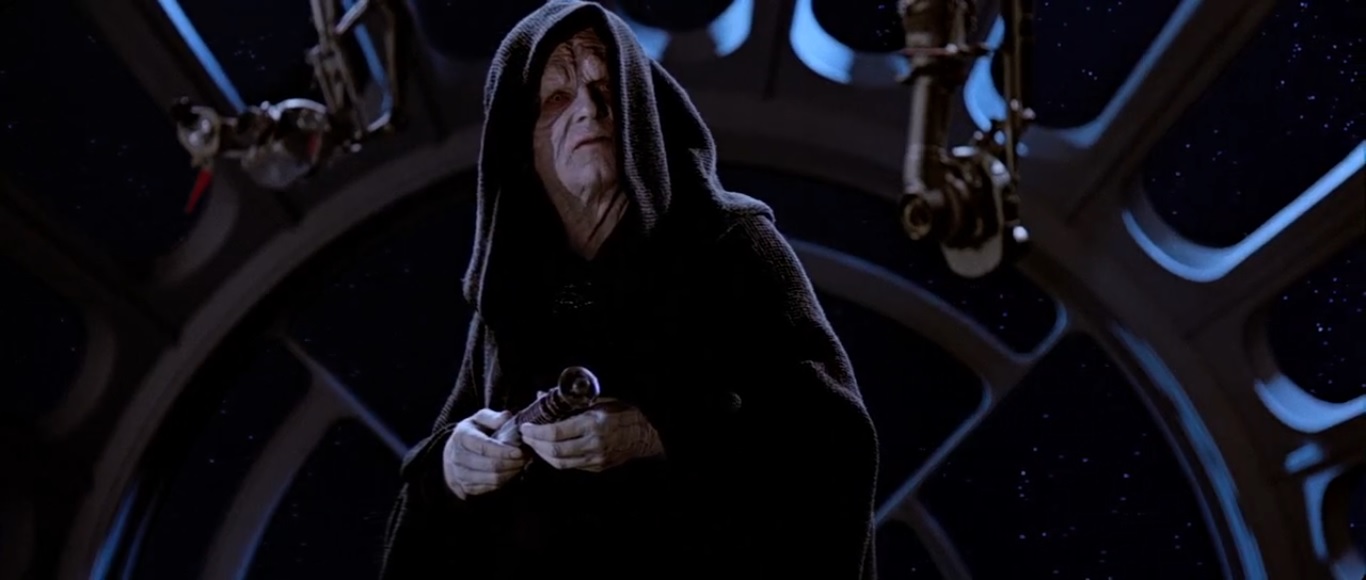
- Sidious' first attempt to end the Rebellion and secure absolute rule of the galaxy using a Death Star was foiled before the station could really
be utilized to accomplish its political goals. This was due to the Rebels gaining secret intelligence and taking out the weapon just after
it came online. Sidious intends to have the superweapon he needs to complete his plan for galactic domination, but also plans to lure
the Rebels into a trap with the promise of not only executing a repeat of this first achievement which will also provide them with
the unbelievable opportunity of eliminating him. Both killing him and destroying a second Death Star before it becomes operational
are absolute top priorities for the Alliance, and the chance at both will undoubtedly lead them to commit all available forces to this
action. As such, Sidious allowed the Alliance to know the location of the shield generator, and made sure the Bothan spies got word
of his 'secret' arrival on the station but also made it look convincing by killing many Bothans in an apparent attempt to keep this from
getting back to the Rebels. Just as at the end of the Clone Wars, he believes that if he plays his cards right, he can achieve his goals,
eliminate his enemies, and bring a powerful new Force-wielding ally over to his side at the same time.
Main Article: Darth Sidious and The Plan
- The legion of Palpatine's "best troops" that await the Rebel special forces team is an Imperial Army unit known as Tempest Force. Based on
unit sizes from the Clone Wars, a legion is a formation of approximately 9300 soldiers. Imperial era unit sizes may differ from those of
the Republic era, however it is unlikely to be much smaller or larger. Republic legions were divided into 4 regiments, which may still
be the case, however only two regiments are identified in the film. One of these regiments is commanded by Colonel Igar, whose forces
are guarding the perimeter and searching the forest, while Colonel Dyer's regiment is based at the shield generator bunker. The infantry
battalion of Dyer's regiment is commanded by Major Hewex, and the armor battalion is commanded by Major Newland, who is in
command of an AT-ST until Chewie pulls him out of it. This armor battalion seems to be equipped entirely with AT-ST's and speeder
bikes, due to the dense forest around the bunker. At least one AT-AT is part of Colonel Igar's force, seen defending the landing pad.
Tempest Force was likely under the command of a Brigadier General, probably based on the Death Star, and if so almost certainly
one of the unnamed officers seen in formation in the Death Star landing bay at Vader or Palpatine's arrival. As some officers seen in
the bunker are present at these reviews, it is likely that Colonel Davod Jon was one of the other two regiment commanders.
- As discussed above, the Rebel fleet at the Battle of Endor is composed of a respectable number of cruisers and escort ships, nevertheless
they are likely to still be at a disadvantage in a battle against a fleet of Imperial capital ships. The main thrust of the Rebel assault relies
upon their starfighters, which is one area where the Rebel equipment is roughly equivalent to that of the Empire. The most powerful
Rebel fighter is the B-wing, which carries enough firepower to make a wing of B-wings a threat to ships as large as a destroyer.
The Rebel fighters of Grey, Green, Red, and Blade squadrons participate in the battle, comprised of A-wings, B-wings, X-wings, and
Y-wings, and lead by the Millennium Falcon. The fighter assault is led by General Lando Calrissian, who leads Gold Squadron
from the Falcon. The leader of Red Squadron is Commander Wedge Antillies, the leader of Gray Squadron is Colonel Horton Salm,
and the leader of Green Squadron is Commander Arvel Crynyd. Although his brief shots were ultimately cut from the film, the gunner
on the Falcon is General Airen Cracken of Rebel Intelligence. The creators of the film created a speed chart for the various
Rebel and Imperial fighters seen in the battle, so that the relative speed of the different ships on screen is as realistic as possible.
This kind of detail ads an uncanny sense of reality to a fictional scene that most viewers aren't consciously aware of. The speeds are
given in megalights, a fictional unit of measure, which at the time were only intended to be used to describe relative speed.
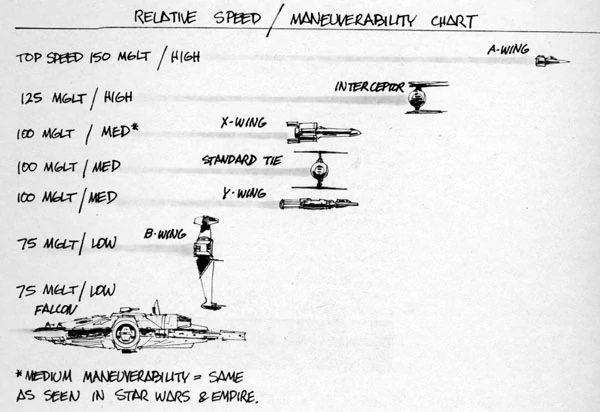
- When the Rebel fleet arrives at Endor, they can't get any reading whether or not the Death Star shield is up. This is less of an example of how
limited sensors are in the SW universe as it is an example of how easy it is to jam sensors. As Lando points out, the Empire would have to
know that the ships were coming to direct an energy field toward the exit from the local hyperspace lane. Otherwise, the Rebels could
have been able to get a reading before the Empire was able to jam their entire fleet. The limitations of sensors may be better shown by
their failure to detect the large Imperial armada parked in plain sight. This may be due to the jamming emanating from the Death Star,
and perhaps the fleet is also jamming from their direction, so that they weren't noticed until someone picked them up visually. At the same
time, electromagnetic jamming does not blind visible light sensors, so the fact that no cruiser had seen these ships suggests that sensors,
like a jamming field, must be purposefully directed in order to detect things, and are not tracking things at all times in all directions.
Main Article: Scanners, Sensors, and Cloaking Devices
- At one point in the battle, TIE fighters are described as "heading for the medical frigate", as they approach a Nebulon-B frigate which is apparently
the hospital ship for the fleet, and very likely is the same hospital ship seen at the end of Episode V where Luke got his cybernetic hand.
After this one line of dialogue, the concept of 'medical frigates' became common in SW material. Nebulon-B frigates are not built to be medical
ships, they are escort-sized armed transports, which is what a frigate is. Medical ships, usually referred to as hospital ships, can be be built
for purpose, but are often simply an appropriately sized ship which has been repurposed for this role, as this ship has been. Other Rebel frigates
in this fleet and in other material are not all medical ships, and hospital ships can be frigates, cruisers, or potentially even a ship classed as
a corvette. Due to this 'brain-bugging', medical ships in SW seem to always be frigates so the writers can refer to them as "the medical frigate."

A couple of brief scenes and some lines of dialogue were cut from the film that contained a 'blow up Endor' storyline,
intended to mirror the countdown to the destruction of Yavin 4 from Episode IV. After telling Luke his friends were
certain to die, the Emperor was to order Jerjerrod to blow up Endor if the Rebels somehow succeeded in bringing
down the energy shield, thus ensuring Luke would have to take action or be certain to lose those he loved. Jerjerrod
is concerned that the Empire has "several battalions stationed on the moon", a reference to Tempest Force, which
does not concern the Emperor. This suggests that Tempest Force, or indeed any legion, is composed of two or three
regiments, which each are composed of two brigades made of two battalions each.
- Major Newland is the commander of the armored battalion of Tempest Force which is operating AT-ST's during the battle with the Rebels
and Ewoks on Endor. He is eventually thrown out of the cockpit along with his gunner, Lieutenant Watts. This unnamed character now
called Major Newland by disney-era supplementary material was known for decades as Major Marquand in Lucas-era supplementary
material, since these two characters were portrayed by this film's director Richard Marquand and co-producer Robert Watts.
Non-canon disney material they consider canon has pointlessly given this character a new 'official' last name, which will be used
going forward. As a result, referring to the character as Marquand Newland best avoids confusion.

When did the Ewoks set up all of the clever traps they use in the battle? Considering the hunting trap and their village's
engineering that was shown, its clear they are an industrious and intelligent people. Nevertheless, these traps are
often specifically designed to combat the Imperial walkers and speeder bikes. Some of this work would have required
noisy construction, or at the very least some very noticeable preparation. Unless they prefabricated these materials
and brought them along, the Imperial patrols of the Emperor's crack legion are really terrible at their jobs. Han
seems totally unaware of the Ewok plans, and it's clear the implication is that they were setting this up while the Rebels
were making their first move on the bunker. While mildly distracted, the many soldiers of this legion should be on
high alert, with many approaching the bunker to secure it. As the film was certainly attempting to suggest, arrogance
was not only the Emperor's fatal flaw but also the Imperial military's, who were too busy chasing rebels with advanced
technology to notice the 'primitive' Ewoks setting up wood and rope traps to drive the Empire off their moon.
- Luke has his second duel with Vader, about four years after their first meeting in starfighters at the Battle of Yavin, and about a year after
their first duel in Episode V. Vader is 45, and though incredibly powerful, he is more conflicted than he seems to be admitting to
himself, and thus is not as committed to the anger and rage that maximizes the power of a Sith. Luke is 23, and is essentially a fully
realized Jedi Knight who has also grown extremely powerful in the Force, and gained much wisdom from it like the Jedi of old. Anakin's
immaculate conception by the Force means that even Luke and Leia probably aren't quite as unnaturally connected to the Force as
Vader, however it is not a genetic trait, so there is no reason to believe that Luke is significantly less Force sensitive. Despite Vader's
significant advantage in experience, Luke is certainly a match for Vader at this point, as he proves by holding his own against
Vader, and ultimately overpowering him. Luke's use of emotions, particularly fear and anger, to defeat his father was indeed
dangerous connection to the dark side, but Luke's Jedi discipline allows him to once again control his feelings and deescalate.
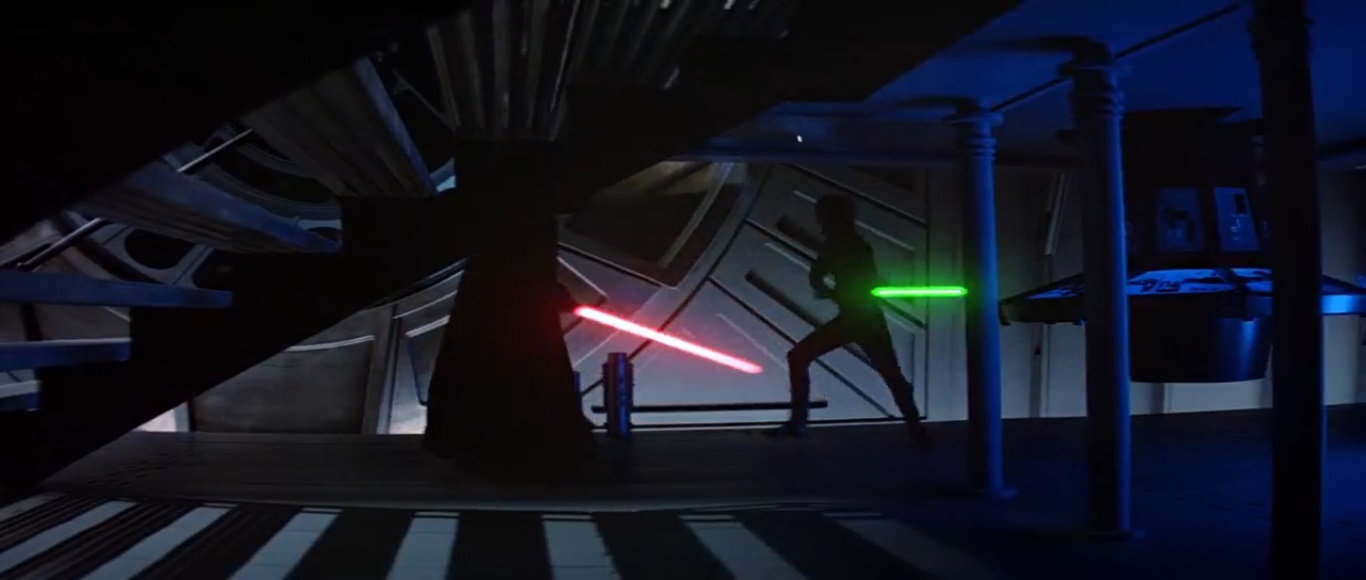
- Luke slices off Vader's hand, the fourth in a series of Skywalker mutilations which become increasingly important to the story until this
culminating scene. First, in Episode II, Anakin has an ambition of defeating Dooku greater than his ability, leading him to lose
his arm in combat, foreshadowing their next conflict and his gradual transformation into a cyborg. Next, in Episode III, Vader
loses his arm and legs in combat with the Jedi Obi-Wan Kenobi, once again overestimating his powers, and setting the stage for
him to be rebuilt by Sidious as a cyborg warrior. In Episode V, Luke follows in Anakin's footsteps and tries to stand up to
a superior Sith and in the process loses his hand, and foreshadowing that Luke is on the same path as Anakin, and may well
end up like Vader. Finally, in this film, Luke's anger and desire to destroy that which he doesn't wish to become lead him to
overpower the Sith Lord, just as Anakin did before his fall, also returning the favor of dismemberment from a previous meeting.
Slicing off his father's hand reveals Vader's machine innards, thus reminding Luke that his desire to do what he thinks is right is
allowing him to be manipulated into following his father's path, which will inevitably lead to him becoming Vader.
- Sidious tells Luke that his hate has made him powerful, as connecting to the Force with passion, rage, and hate will magnify one's power.
Sith Lords replace each other by defeating a more powerful one in combat. Luke's rage against Vader for threatening Leia, and his
hatred of the idea of following his father to the dark side, temporarily overwhelms his Jedi restraint, making him too much for Vader
to handle in combat. The true trap of the Sith is that confronting them empowers the dark side. The only way to truly defeat
the Sith is not to fight them, nor to surrender to them, but to deny them the conflict which they are seeking to fuel. Practically,
that usually still requires some kind of combat with them, and even though Luke connects with his anger, he still does as a Jedi
should, fighting a Sith Lord only until he is disarmed and put in check, and then refusing to murder his defeated opponent.
Killing a Sith Lord in combat does not make one evil or turn one to the dark side, however connecting with anger and hate can.
- Sidious attacks Luke using a power usually referred to as Force lightning, the first instance we had seen of this powerful application of ability
with the Force. According to supplementary material it is a power only possible using the dark side, as it is an unnatural collection and
release of Force energy which can only be used to disrupt or destroy. One must not only be powerful with the Force, one must have
specific knowledge of the dark side to use this ability. It does not seem that Darth Vader, for all his power, was ever taught this ability
or learned it on his own. Sidious would naturally wish to preserve at least one powerful advantage over Vader, who is naturally stronger
in the Force, other than Sidious' chief advantage of powerful and usually accurate vision through the Force. Darth Tyranus, better
known as Count Dooku, is the only other Sith that has been seen to use this ability. He may have been so knowledgeable with
the Force as an accomplished Jedi Master that he learned to access this himself, or would have, however it is most likely that Sidious
taught him this ability since he was acting as Sidious' proxy on the frontlines in a war with the Jedi, and would need this power to remain
one step above so many powerful adversaries. George Lucas described the Force lightning as a physical manifestation of Sidious'
anger at Luke and disdain for the Jedi, meant to resemble the lashing out of a wounded animal.

When the shield goes down and the Rebel ships enter the Death Star, there was another brief scene with Jerjerrod in
Death Star's command center, where he is informed that the rebel fleet is moving to the unfinished portion of
the station, and that Rebel fighters have entered the superstructure. Jerjerrod's reaction is one of concern but also
calm leadership under pressure. He gives the order to "open the power discharge gates, flood sectors 301 and 138",
suggesting "That should slow them up a bit." This was one of three scenes for Moff Jerjerrod that were removed,
leaving him with only one scene with dialogue, which was the first scene of the film. This scene about the Rebels
flying into the Death Star was removed mostly because it included conversations about the 'blow up Endor'
storyline which was entirely removed from the film, deemed an unnecessary story complication.
- After all, Anakin is the hero of the SW trilogies. He returns as a Jedi, killing Sidious and in the process ending Vader, completely breaking
the ancient unbroken line of Sith teachers and apprentices, fulfilling the prophecy that the Chosen One would destroy the Sith and
restore balance to the Force. Anakin's immaculate birth by the Force to correct the cosmic imbalance was the will of the Force,
but Anakin's choices decided what path he would take to his only true destiny. The path he chose was very rocky, but still got there.

Why did Darth Sidious explode when he died? There is no canon explanation for why it happened, and the script simply
confirms that it did happen, saying "the Emperor's body spins helplessly into the void, arcing as it falls into the abyss.
Finally, when the body is far down the shaft, it explodes, creating a rush of air through the room." Amongst the many
theories, the least compelling is the idea that he hit into a rector, some even claiming he hits the main reactor. This is
obviously not correct, as the main reactor is 100 km beneath the Emperor's tower, and he falls for about 7 seconds.
He falls to the bottom of his tower, and as he falls we can see the elevator shaft on the left which Vader and Luke
used in the film to reach the Emperor's throne room. As is seen in the film, Sidious was in the midst of conjuring up
and releasing unnatural concentrations of energy pulled directly from the Force to target Luke. When Vader grabs him
unexpectedly, this release continues, but now begins to loop back and hit Vader and himself. As he falls down the shaft,
we see that this energy is still being accessed and released out of his hands, seemingly beyond his control to stop.
It must be either of the two more sensible theories, one being that this energy caused him to explode in an overload,
or simply released in a huge burst when he hit the surface. Either makes sense, but ultimately the reason Sidious
explodes is that the creators wanted to emphasize to the audience that he was absolutely dead, disintegrated, and gone.
- The shield generators on Imperial warships which protect the bridge are generated from two large polyhedronal towers situated on top
of the command tower. Imperial ships, like many warships in the SW universe, use isolated and extruded command towers which
give an excellent view of surrounding space. This is not the primary reason for this design, as the principal purpose is to create
a physically small piece of the ship which has significantly stronger shielding. The larger the size of an object a shield must protect,
the weaker it is at any one point. Generating shields around an area as small as a bridge allows for minimal shield surface area,
and allows the bridge to be safe from direct attack without costing an absurd amount of power. This is of course why starfighters
are such dangerous attackers, and why ships the size of a star destroyer must carry their own fighters to prevent enemy ships
from targeting these bridge shield generators at close range. Without the extra protection the bridge is far more vulnerable.
Main Article: Shields, Deflectors, and Ray Shields
- The destruction of the Executor clearly illustrates the importance of the bridge shields just discussed. Command towers are a great concept
with a great historical track record, but when something goes disastrously wrong in a battle and the bridge shields are lost, it creates
a way for smaller, less-powerful ships to potentially take down a large warship without having to overcome its thick hull, its hull shields,
or its main guns. Green leader, Commander Crynyd, uses his damaged fighter as a missile in a suicide run, slamming directly into
the unshielded bridge. This leads to havoc with the Executor's control systems, sending the ship listing out of control into the Death Star.
The subsequent collision causes their power systems to overload and the entire ship to be incinerated by reactor breach.

- Due to the circumstances of his defeat and near death in Episode III, Anakin requires machine assistance to live. His suit is pressurized as a result, and
though he can survive without his helmet on, it is presumably only for short periods. Anakin suggests this is irrelevant now, since the shock to his
system from having his cybernetic arm cut off, combined with an intense dose of Force lightning at point plank range has made death imminent.
- Luke meets his father Anakin for the first time, and gets to have a real conversation with him and see his face. What Anakin had always wanted
was not to be powerless, and thus he wanted power and that is what he got, in the most unfortunate way. What Luke had always actually
wanted was something he was raised to believe was impossible, to meet and know his parents. Luke got to meet his father, and despite
the tragedy of losing his father immediately afterward, Anakin was able to communicate to him that he loved him, was proud of him, and
most of all to thank Luke for saving him from the living hell he had created for himself. Anakin's heart was never gone, he was just doing
everything in his power to repress it, and using the dark side is like an addictive drug which rewards that repression with greater power.
Now that Anakin is free from its influence, and that of Sidious, he can think clearly again, and most importantly, feel clearly again.

Did the destruction of the Death Star inevitably lead to a moon-wide disaster referred to as the 'Endor holocaust'?
While some fans have gone into great detail to prove scientifically that this would have indeed been the case, as this is
a fictional destruction of an orbital battlestation made out of things we can't possibly know the material composition
of, there is certainly no way to 'prove' that this must have occurred. Those who have analyzed this scientifically should
be applauded for their love of SW and their interest in keeping this series science fiction. Proponents of this theory
like to point to the relatively few but certainly noticeable chunks of flaming debris that are indeed seen shooting in
several directions, including a few towards Endor. The initial explosion caused by the destruction of the reactor caused
a massive internal explosion which chased the Falcon out of the superstructure. As can be most clearly seen as
the Falcon is flying away from the exploding station, when the energy of this explosion succeeded in fracturing
the giant kyber crystals integral to the main weapon of the station, the vast majority of the station was flash-vaporized.
Remember this station had the potential to unlock enough energy to blow up an entire planet. If even a small fraction
of that power were released internally, which it certainly was, there would be nothing left of a comparatively brittle
and hollow egg like the Death Star. Indeed, due to the way the station exploded, the destruction was not perfectly
uniform, and as many as a dozen burning chunks are seen flying off in various directions. Compared to the size of
the station these are no larger than a star destroyer. If a dozen burning star destroyers were flung down upon Endor,
whatever hit would certainly damage a small area, but would not lead to moon-wide devastation. As is clearly
visible in the film, the Death Star was for all intents and purposes completely vaporized. There was nothing large
enough to cause devastation by raining down on Endor, and no part of the Death Star survived intact anywhere.

- Leia uses the Force to sense Luke is still alive after the destruction of the Death Star, her first display of her incredible natural aptitude with
the Force. Much like Luke in Episode IV, she begins to be able to use the Force in its most basic ways soon after being told that
she has the potential to wield it. The only thing keeping such people back is the notion in their own heads that they are limited by
the same things as everyone else, which is understandable. Once open to the Force, a wielder can learn a great deal without a teacher.
As part of the great return of the Jedi, not only does Anakin come back and Luke is confirmed as a Jedi Knight, but Leia also takes her
first steps on what is obviously intended to be the Jedi path. There will now be two Jedi to continue on in the ways of the Force.
- The Special Edition features a montage of galactic parties celebrating the death of the obviously unpopular Emperor. These updated editions were
released in anticipation of the prequel trilogy, and sought to more fully integrate the two storylines. As such, this is in fact the first appearance
of Naboo and Utapau, which at the time were yet to have been identified. The montage shows Cloud City on Bespin, Mos Eisley on Tatooine,
Theed on Naboo, Pau City on Utapau, and Monument Plaza on Coruscant. The party on Coruscant includes fireworks, a stormtrooper being
tossed around by the crowd, and the toppling of a large statue of Palpatine. It is said in legendary material to have been soon attacked by
Coruscant Security Forces, leading to the Monument Plaza Riot and the subsequent series of conflicts known as the Coruscant Civil War.

While the scene was never deleted, Anakin's appearance as a Force spirit was edited by George Lucas in 2004, and
footage of Hayden Christensen, who plays Anakin in the prequel films, was used instead of Sebastian Shaw who plays
Anakin in this film, and who was just seen a few scenes earlier. This highly-controversial decision was done to give more
continuity to the six SW films as a whole, and to suggest that what Anakin had become since he was last a Jedi was not
the part of him that would live on. Christensen was not told the establishing shots he was asked to do were intended
to be superimposed over the original portrayal. Anyone who is familiar with the controversy will be aware that for
a diverse range of reasons many fans were not at all happy with this particular editing choice.
- Anakin becomes a Force spirit even though he does not learn Qui-Gon's path himself, and does not transform into the Force at death. Whether
this was a gift of the Force for fulfilling his role as the Chosen One that he was born for, or whether this was Obi-Wan and Yoda's doing is not
specifically known, however non-canon and supplementary material seems to favor the former rather than the latter. In an early draft of
the film, Anakin was to enter the netherworld of the Force where Yoda would "rescue him before he becomes one with the Force."
This suggests that, as often is the case, the legends community arrived at the opposite concept of what Lucas had imagined it would be.
ANALYSIS
The decision to begin a second Death Star immediately after the first station's destruction was both a Sith priority and something of a tactical necessity
for the Empire. The station represents a longstanding goal of Sidious to possess a Sith superweapon which can rule the galaxy with fear that he can
live on. An entirely artificial world which uses Force crystals to destroy whole planets, and is inhabited by a loyal society that is ordered and dedicated
to solving problems with violence and power is the realization of Sith philosophy and Sith goals. The Empire now needs this weapon to stop the rebellion
before it becomes impossible to contain, a situation it created for itself by openly destroying Alderaan. That move was only politically viable and an effective
deterrent as long as the Empire's ability to destroy a planet or entire fleets at will remained. The destruction of the first Death Star immediately after its
use against Alderaan was the worst possible outcome for the Empire, as its enemies multiplied once its true evil face was revealed to the entire galaxy.
Despite the urgency, the second Death Star is even larger than the original. The redesign is evidence that the Emperor was rightly confident that the Imperial
military could rule the galaxy with force long enough to complete this station. It also has the benefits of being even more powerful, and of course not having
a dangerous design flaw which was intentionally left poorly-defended. The original had taken 19 years to build, primarily because it was a prototype which
had an unproven weapons system which took a decade to perfect, but also because the work was highly secretive and undertaken carefully so as to avoid
detection by the Senate. Work on the second Death Star which was completed in 4 years would have taken much of a decade if constructed in that manner,
thus the Empire proceeded to strip mine planets for resources using massive amounts of forced labor. Despite the secrecy still employed about this second
Death Star project, this kind of open exploitation was possible in the Civil War period because the Empire had abolished the Senate and dropped its mask
of friendly pretense. Moff Jerjerrod was placed in command of construction, presumably because he was an effective officer. Despite his efforts to meet
the Emperor's timetable, the gargantuan work force under his command is struggling to complete the weapon in time. Sidious has seen through the Force
that there is an opportunity to eliminate the Rebel Alliance and to convert Luke simultaneously, but this requires everything to be ready in time. As a result,
Sidious has dispatched Vader to speed up the already breakneck speed of construction. Regardless of whether the Alliance is destroyed or Luke is converted,
once this Death Star was operational and its interior was properly armored the Empire would have been able to win the Civil War and reestablish galactic tyranny.
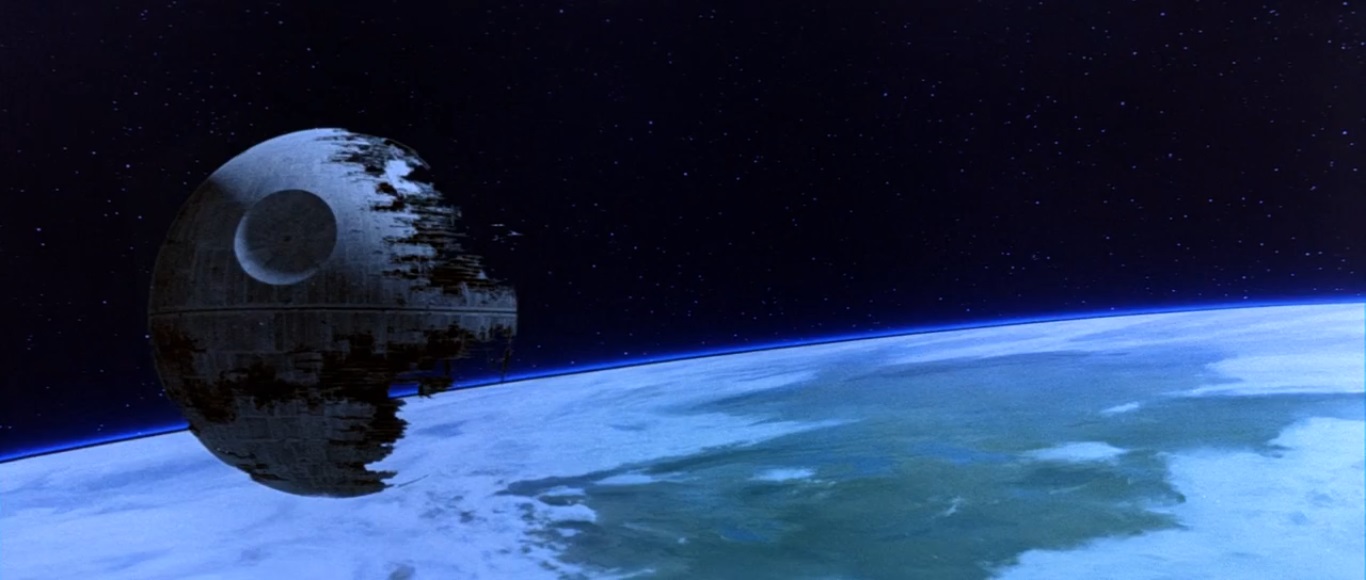
The power of criminal organizations grew significantly during the Clone Wars, as the Jedi's attention was occupied and the Republic was under siege.
While the criminal underworld and semi-legal black market were always a feature of the Republic, their free rein to expand grew dramatically with the help
of the Sith, both before and during the Clone Wars. Criminal syndicates are ideal agents for spreading Sith philosophy, as they are greedy, opportunistic,
violent, and oppressive. They act as agents of chaos for those trying to preserve law, and act as agents of order and authority over the many people who
live in their operating territory, and best of all, they don't have to be ordered or convinced to act this way. Races and planets which were more independent
and isolationist from the Republic were typically the base of operations for these syndicates, most notable of all being the Hutt Cartel, which controlled
a huge region of the Rim which was by treaty with the Republic an autonomous region. While the Empire presented itself as a security state interested in
returning order to the chaotic galaxy after the Clone Wars, the Empire not only allowed the criminal syndicates to keep their gains, it largely allowed their
free rein to continue. The Sith wish every aspect of life to be unnaturally controlled and drained of compassion, and that includes the daily life of simple
people far from power. A galaxy with local mobs, gangs, and syndicates everywhere allows this kind of bleak order to be imposed on as many corners of
society as possible, without the Empire having to fund and lead the effort, or have its name attached to the misery it spreads. The Hutts retained a fair
degree of autonomy under the Empire, however unlike the Republic, the Empire operated freely near or on planets traditionally considered to lie within
Hutt Space. It is ironic that Hutt Space was probably the area of the galaxy most free under the Empire, as slavery returned in Hutt Space and adjacent
territories faster and to a greater degree than in the Empire itself. The Empire's fascist economy preferred to employ forced labor, which is itself a kind of
slavery, however the buying and selling of people to private owners was still far more widespread in the Rim. As many would be aware from history,
including and especially Jabba, the return of the Jedi Knights would once again pose a considerable threat to organized crime and slave trafficking.

Sidious' manipulation of Vader is very much the same as his manipulation of Anakin. He appeals to Vader as his only true friend and ally, and treats him
almost with respect, something he would not do for most. That respectful tone is still condescending and authoritative, as his charisma as a leader is
why Anakin was drawn to him in the first place, and he wishes to constantly remind Vader that he knows best, knows more, and can see the future.
The soft spot for manipulating Anakin was always those who Anakin cared about, and Sidious is at least partly aware that Vader has unusually strong
feelings about finding Luke. Vader portrays his interest in Luke to the Emperor as simply a desire to contain a threat, but Sidious understands who he
is dealing with, and more importantly, intends to use this to keep Vader in line and to lure Luke to them. Sidious entices Vader with the promise of
working together to bring Luke into the fold, telling Vader, "He has grown strong. Only together can we turn him to the dark side of the Force."
In essence, Sidious is getting his prize fighter prepared for the big fight, as he will need Vader to antagonize and confront Luke in order to provoke Luke,
and as always to protect him if needed. To ensure that Vader keeps his loyalty to his "friend" and master, Sidious reminds him that everything that
is transpiring in the war and with Luke is "proceeding as I have foreseen." Vader has every reason to believe that things will transpire just as they did
during his fall, and that he must continue to side with and obey his master if he is to succeed. He believes he is destined and cannot choose, and
thus will not allow Luke to attack the Emperor. Sidious is so confident that Vader's years as a Sith have left him irrevocably dead emotionally and
that Vader will have no problem helping him corrupt his son, directly telling Vader that Luke's "compassion for you will be his undoing."
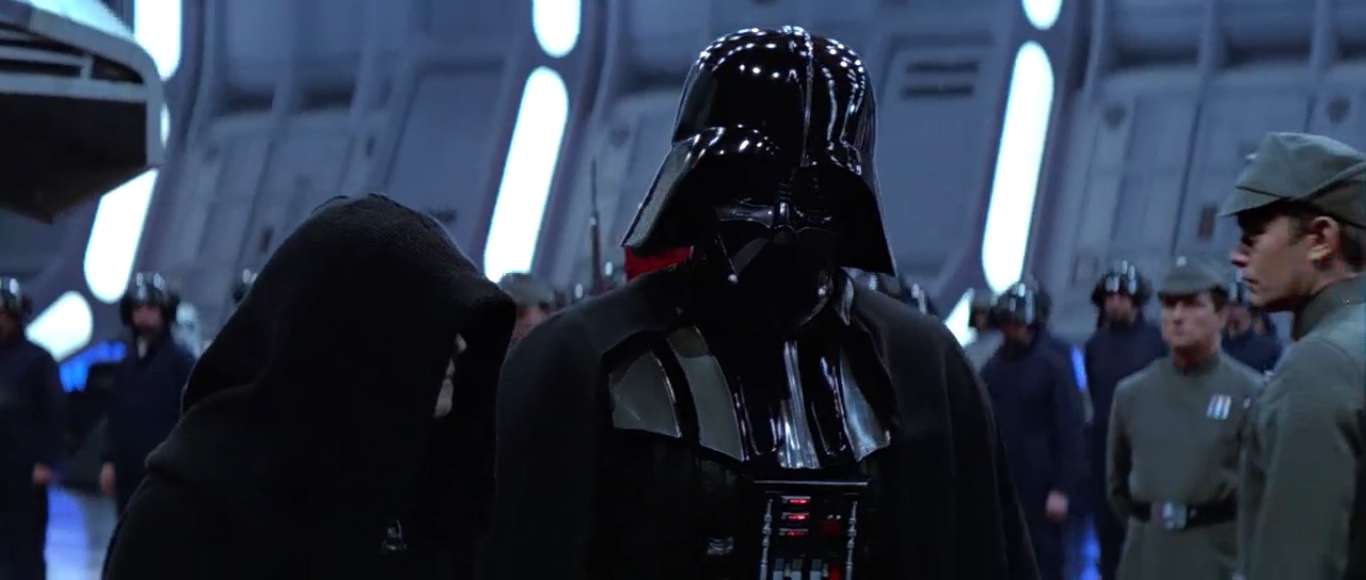
Yoda tells Luke he must confront Vader before he would truly be a Jedi, both because this would constitute passing the Jedi trials and because it would
solve the internal conflict which was clouding Luke's commitment to the Jedi path. In order to progress in the Jedi Order, the students had to pass tests
and trials to determine that they have truly mastered various stages of their training. These trials were usually 'judged' by the Force, which the Jedi
discern has allowed a student to pass by overcoming whatever challenge the Force saw fit to put before them. The Force always challenges a learner's
weaknesses, offering them opportunity to overcome them. Sometimes, as with Padawan Obi-Wan's confrontation with Maul, when a student is ready
to be tested, real world events take the place of a planned exercise, as it is the Force itself which confers a higher standing upon the Jedi. Luke's need
to solve his internal conflict of fighting his father or saving his father will be solved, removing this cloud from his path. Yoda confirms that Luke does
not need anymore training from another Jedi, and that he already knows what he needs to know, and possesses the skills necessary to confront
the Sith. Indeed, it is the way of the Jedi that they must confront Sith, as the Sith must be stopped from the evil that they work in the world, but this
does not necessarily require killing the Sith, and it certainly doesn't require anger or hate. It does however require that Luke be prepared to kill his
father if necessary, as a Jedi cannot let their sympathy get in the way of serving the light side of the Force. The central conflict of Luke's storyarc is
that he wants to be a Jedi like his father Anakin, but having learned that his father lives and is a prisoner of evil, he also wants to save his father.
At this point, this still seems like an either-or proposition. Yoda, however, seems confident that Luke's essential goodness will lead him to make the right
decisions. He is more confident than the spirit of Obi-Wan seems to be, as Yoda is to the Jedi what Sidious is to the Sith: their wisest, most powerful seer,
who is confident in the rightness of their cause, at times overconfident. This time Yoda has put his trust in the right place, but like Sidious' conversation
with Vader, he too must get his prize fighter prepared for the big fight. Yoda demonstrates his respect and approval of Luke and what he has
accomplished already by speaking to Luke as the new leader of the Jedi Order, affirming that he has truly earned Yoda's trust and confidence.

Obi-Wan withholds things from Luke the way he withheld things from Anakin, threatening to drive the same wedge between Luke and himself which
contributed to Anakin's disillusionment with the Jedi Order. He now attempts to explain himself to Luke by being honest about his history with Anakin
and his role in Anakin's fall to the dark side. As prodigious a Jedi as Obi-Wan was when he began teaching Anakin, it was probably Obi-Wan who was
too young to be the proper teacher, rather than Anakin being too old to begin training. Obi-Wan clearly feels that he let down his friend and bears
responsibility for what Vader has helped to do to the galaxy. Obi-Wan suggests Yoda would have been a better teacher, and maybe so, but as Obi-Wan
points out, young Anakin was amazingly strong with the Force. His becoming a great pilot and seeking adventure were part of his nature as a child
conceived by the Force to accomplish a great task, and that recklessness and desire to seek greater power may have been beyond any Jedi's ability
to harness, precisely why the Jedi Council did not want Qui-Gon to train him in the first place. Regardless, Obi-Wan feels that Anakin really is dead
and gone, calling him "more machine now than man. Twisted and evil." Luke's conclusion that he can't kill his own father is precisely why Obi-Wan
kept this from Luke in the first place. Obi-Wan's reaction is to tell Luke, "Then the Emperor has already won. You were our only hope." Obi-Wan is
now being completely honest with Luke about his role in all of this, specifically that this is an old fight between the Jedi and Sith each trying to defeat
the other, with Sidious vs Yoda and Obi-Wan first involving Anakin in their struggle, and now Luke. While both sides are manipulative and primarily
concerned with their goals and mission, the Sith employ intimidation and threat, and tell the Skywalkers it is their destiny of which they have no choice.
The Jedi may be deceptive, but they offer their students free choices, and trust that the Force will guide them to do what is right.
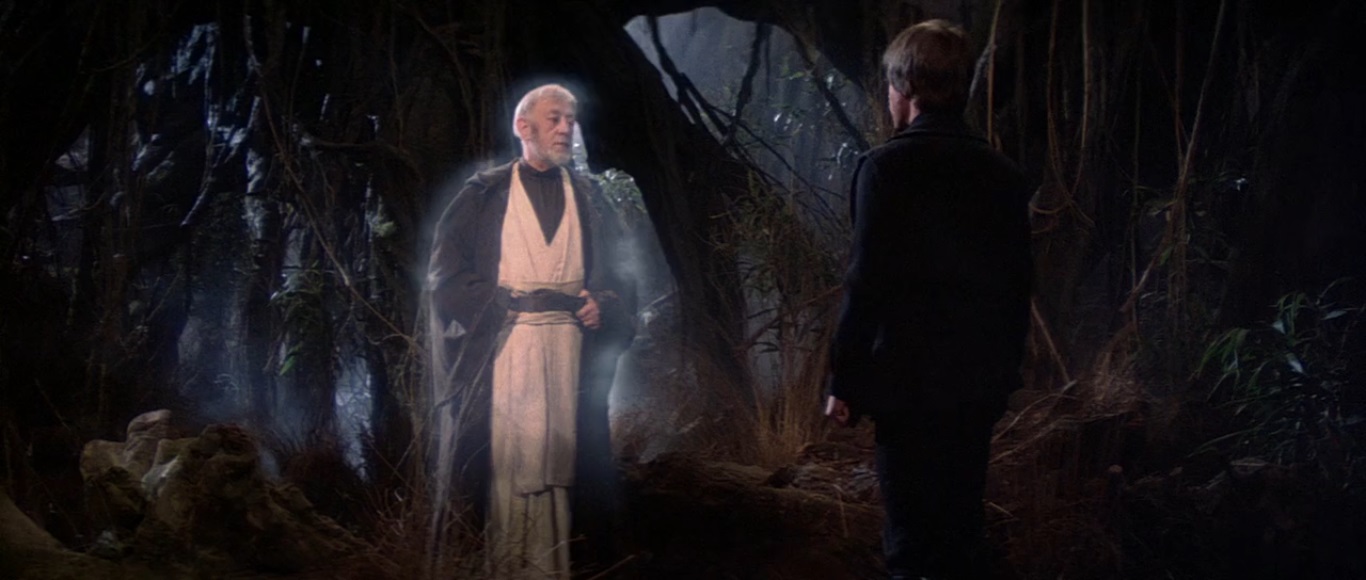
The Rebels are willing to believe the Death Star may be "relatively unprotected", since the Imperial Fleet is "spread throughout the galaxy in a vain effort
to engage us." While the Empire has the upper hand in the Civil War, it is dealing with two primary strategic challenges, the first being rebellious populations
and local insurgencies on many thousands of planets, and the second being the elusive Rebel fleets conducting a guerrilla war against their resources.
This means the Empire must deploy their fleet broadly, both a defensive forces around critical planets and facilities, and as offensive fleets hunting for
Rebel fleets and facilities. These advantages for the Rebels are somewhat limited by the difficulty of amassing large enough fleets to take down targets
of sufficient value to warrant the inevitable losses. While the Rebel Fleet has grown significantly, their total number of ships is still a limited resource,
and large fleets inevitably draw attention, as they require fuel, give off signals which can eventually be detected by probes, and must have ships coming
and going from staging areas in order to conduct operations. This is why the Bothan spies' data about the non-operational Death Star being visited by
the Emperor was literally an incredible opportunity which was both believable and impossible to pass up. The Rebel attack need only neutralize the shield,
and by bringing the most powerful naval force they can, should be able to handle whatever defense the Empire can spare for this project. The Rebels
also assume that the remote and secret construction location is intended to be a large part of the Empire's defense plan, since no one ever would go to
Endor looking for the Empire, as indeed it is unlikely anyone has a reason to visit a little-known, primitive backwater with no spacefaring infrastructure.
The Rebels therefore collect all of their most powerful warships, the majority of their advanced starfighters, their best army units, and their most valuable
officers, and commit them to a single action which will either tip the scales in their favor or lead to the Empire inevitably fielding a fully-functional Death Star.
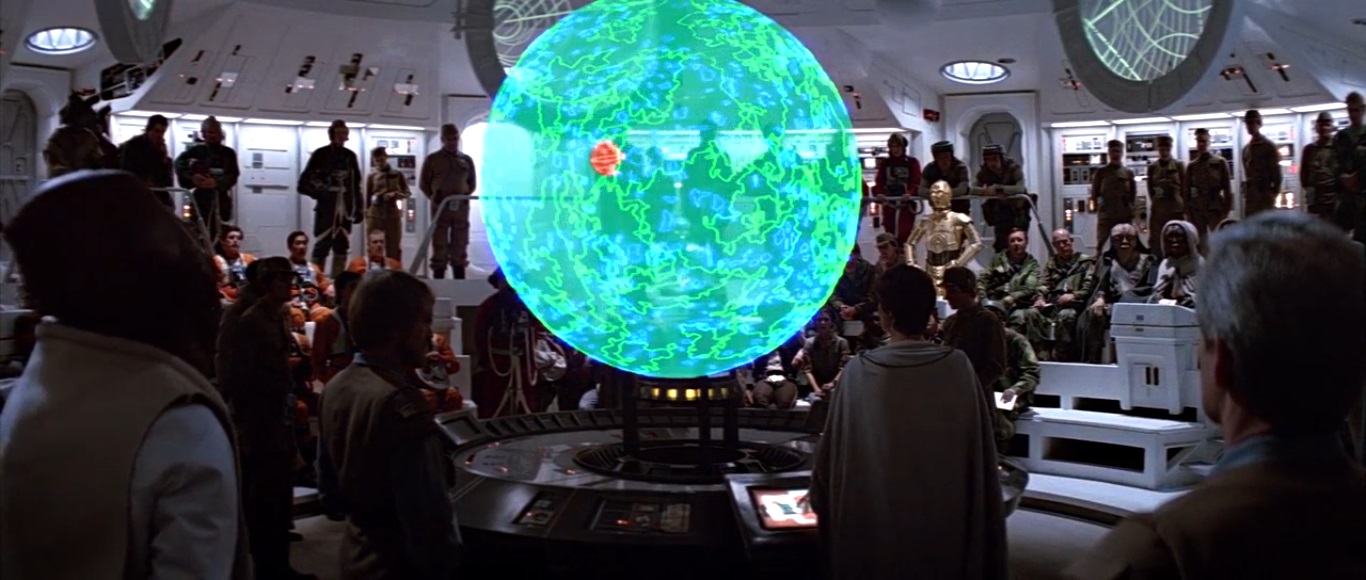
The Empire is a highly-centralized authoritarian government which is directly administering hundreds of thousands of starsystems and presiding over
millions of worlds theoretically within its jurisdiction. This requires a monumental bureaucracy and military, so like most authoritarian empires or
fascist states it places military officers in direct political power to streamline the process. The Empire's system of military governors, including sector
governors known as Moffs and regional governors known as Grand Moffs, is designed to compartmentalize the decision making process. Put simply,
a government like this which relies on micromanaging everything needs administrators at every level who understand the leadership's goals and intent,
so the right decisions can be made without having to trouble their already busy superiors. The higher one gets in the chain of command, the more that
individual has to understand the big picture, and to have been promoted to such a rank must be known as an enthusiastic supporter of the leader's
policies. This is often to the detriment of the military as a combat force, since many officers are simply career-minded politicians climbing the only
political ladder available. Nevertheless, this ensures that the Emperor and his court will receive any and every report they need to know, without being
overwhelmed with millions of daily reports and requests for action. As a result, Palpatine's court are made up of some very intelligent, ruthless, and
capable administrators who more or less are completely on board with Palpatine's plans. As is seen in the film, Palpatine and his ministers are still
conducting galactic affairs from his tower, which in future is intended to be the center of Imperial government. Vader, on the other hand, is used by
the Emperor as his personal intimidator and enforcer, and is kept out of the chain of command. Vader is only sent in to take charge of things in
the Emperor's name when the Emperor wishes to scare his subordinates, and otherwise has no direct authority in the command structure. Sidious
needs to keep Vader feeling inferior to him and keep his apprentice from accruing any political power or being placed in a position where he could
eventually move against him with the support of others. Relegating Vader to a largely military role is serving Palaptine in very much the same way
that he did in the Republic era, and keeps Vader entertained and busy working with officers who are more loyal to the Emperor than they are to him.
Vader's military report that the Rebel fleet is massing near Sullust is dismissed as unimportant by the Emperor, chiefly because this is part of his plan,
but also because if Vader has seen this report, Palpatine and his ministers have certainly already seen it as well.
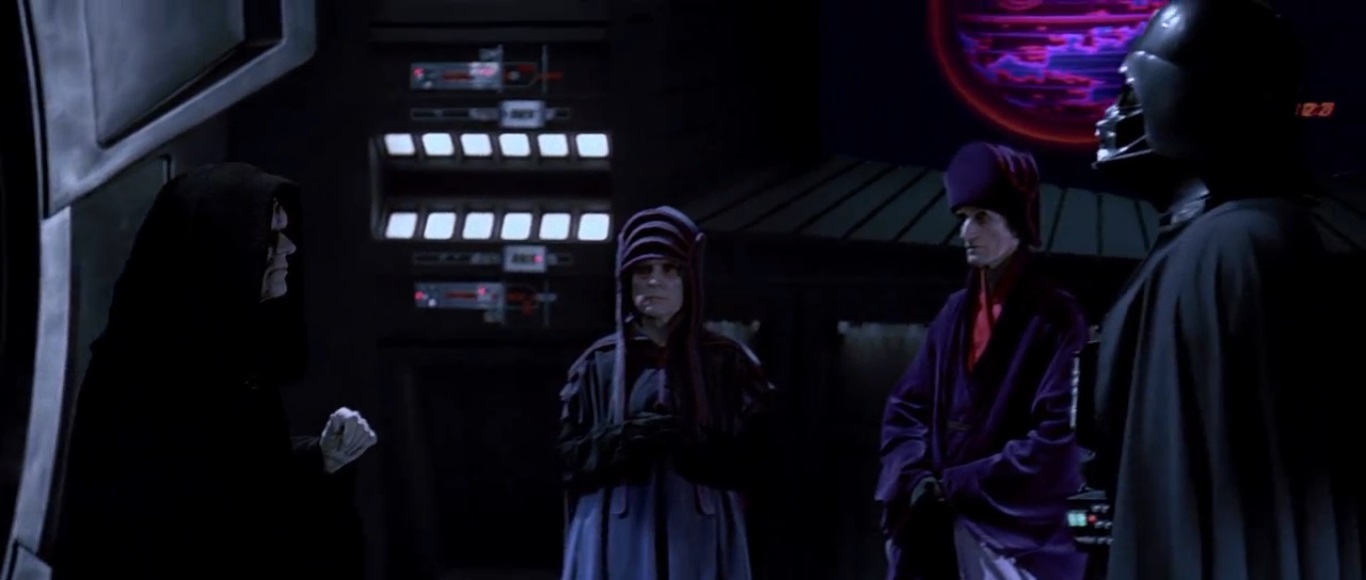
Luke attempts to use his personal relationship with Anakin to attempt to convert him to his side and help him overthrow the existing order, just as
Palpatine had done 23 years earlier. The conflict within Vader which raged back then is still present, as Luke tells Vader he has felt, meaning that
nothing about his destiny is absolute, and he could still choose a different path. Sidious has convinced Anakin that he cannot be anyone other than
Darth Vader ever again, and treats conversion to the Sith very much as the Jedi do, seeing it as essentially the murder of the good person within,
which the Sith see as limited and weak. In order to embrace the dark side and maximize his strength Vader must also tell himself that the Jedi Anakin
is dead, and tries to disassociate himself from feelings and emotions he once had as Anakin. Vader tells Luke that the name Anakin Skywalker no longer
has any meaning for him even though he acknowledges Luke as his son, since admitting that he is still Anakin would force him to reconcile his actions
with the emotions which led to them. Vader's raised voice and abrupt answer about the matter suggest this has touched a nerve. Despite Vader's
denial of the good that is still in him, his conversation with Luke demonstrates that he does care something for him, as he lets down his guard a bit
and tries to let Luke down gently about the fact that he is turning Luke down and will indeed turn him over to the Emperor. Vader tried to sever Luke's
connection to Anakin's noble Jedi past when he cut off Luke's hand holding his old lightsaber, which Luke was carrying in honor of his father. Luke's new
lightsaber indicates that Luke's mission is his own, and he is a Jedi whether his father was or not. Now that Vader is connecting, however awkwardly,
with his son as a father, it is reminding Vader what caring feels like. Luke's proposition that Vader can simply let go of his hate plants a seed in Anakin's
mind, the same way that Palpatine encouraged Anakin to simply let go of his dogmatic morality back when Anakin fell to the dark side. Vader insists
"It is too late for me, son", and tells Luke that "Obi-Wan once thought as you do. You don't know the power of the dark side. I must obey my master."
The idea that he could ever be converted to the other side of the Force seemed impossible to Anakin not long before it was first accomplished.
Vader's conversation with Luke starts him thinking about again placing himself and his family above his loyalty to those he serves. Nevertheless,
Vader still believes that Sidious will prevail as he always does, telling Luke that he "will show you the true nature of the Force. He is your master now."

All three parts of Sidious' endgame can come together perfectly if his new Death Star becomes operational, the Rebels bring their combined forces
to Endor to be destroyed, and Luke can be converted to the dark side by threatening his friends during the battle. This is the second great culmination
of Sidious' plans to rule the galaxy, the first having occured 23 years earlier when he eliminated the Jedi and seized unending power over the Republic.
This second culmination was supposed to have occured 4 years earlier, when his plans to activate the Death Star and destroy the pesky Rebel Alliance
were thwarted by Luke. Sidious' master plan never truly ends, as he will keep transforming the galaxy according to his will, aided by his vision through
the Force, however each of these culimating points mark a significant advancement in the degree to which Sidious can directly and openly rule
the galaxy as a ruthless Sith Lord without hindrance. Sidious seems to believe that converting Luke will be as easy as converting Anakin, despite the fact
that over a decade of friendship had existed between him and Anakin before his fall. Luke is far less likely to be impressed with the Emperor's supposed
wisdom and greater understanding. At the same time, Sidious knows that his Death Star has just become operational, the Rebel fleet is indeed on its
way, and with everything set to attend to itself he believes he need only use the situation to manipulate Luke and his triumph will be complete. It is
likely Sidious has seen this a possible outcome shown to him by the Force, and decided to trust that it is what will occur as he did many times before
including at Anakin's fall to the dark side. His faith in the Force and its favoritism towards himself and the dark side fuels his arrogance. Nevertheless,
since so many of his visions have come true, especially after he used them to manipulate events, he has little reason to doubt his ultimate success.
He is probably being very honest about his beliefs when he tells Luke "You will find that it is you who are mistaken...about a great many things."
His arrogance and the fall it will precipitate is foreshadowed by his openly putting Vader down and suggesting Vader is too weak to overcome him.
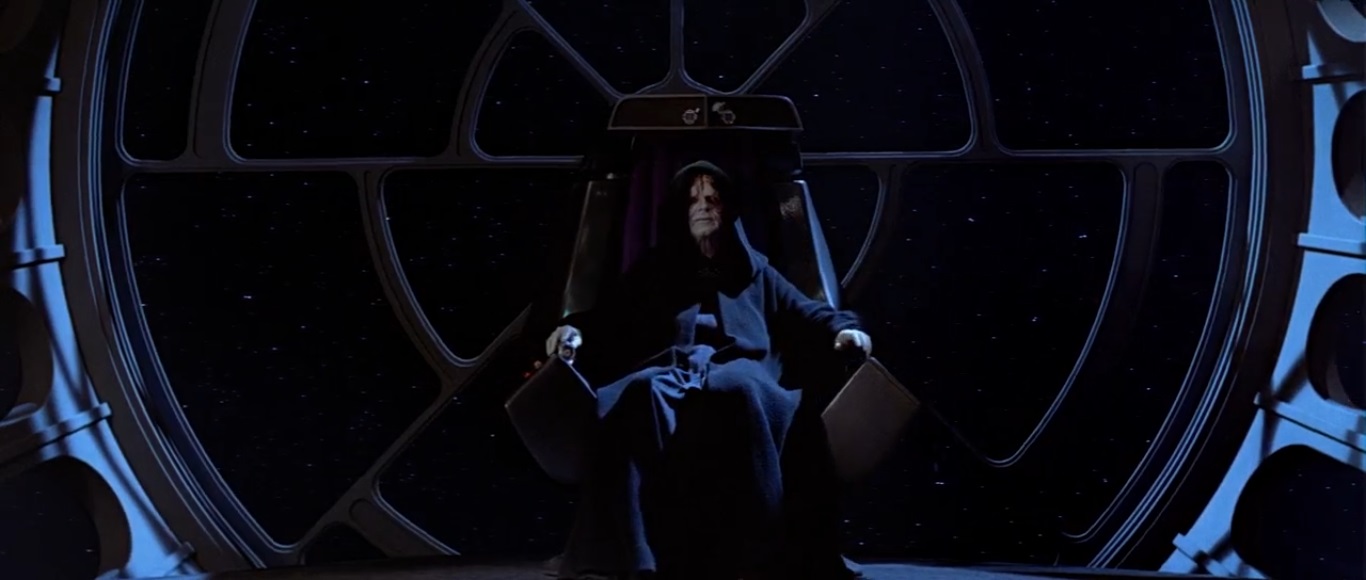
The Battle of Endor began with the Rebel fleet falling directly into the Empire's trap and fighting a holding action designed to buy time for their ground
forces to lower their defense shields. The Death Star's main weapon was operational, the scant defense force guarding the project was in fact a sizable
Imperial fleet of over thirty destroyers escorting an Executor-class dreadnought, and the shield generator was defended by an Imperial legion, which
is roughly the size of a standard army division. Basically the only part of the intentionally leaked information that was correct was where the Death
Star was located, that it had a shield, and that Palpatine was actually there. Despite the decent collection of warships the Rebels were able to field,
the Imperial fleet under Admiral Piett is too substantial for the Rebels to realistically expect victory in a close range battle. The fact that the Death Star's
main weapon is active makes their chances of surviving the battle almost zero, let alone achieving any kind of success. Lando's faith in Han's ability
to get the impossible done no matter what is the only reason the Rebel Alliance didn't execute a hasty and costly retreat from the battle, losing their
only opportunity to destroy the station before it is completed, and certainly to kill Palpatine. The demonstration of the Death Star's weapon against
starships shows why this station is a game-changing weapon. Not only can it eliminate entire planets, but it can vaporize large warships which have
no realistic possibility of seriously damaging the Death Star, no matter how numerous they might be. Admiral Ackbar takes the Rebel fleet in amongst
the Imperial star destroyers hoping to shield his ships from the Death Star while they continue to buy time. The longer that engagement went on,
the fewer Rebel ships would remain, however the Rebels did successfully destroy or severely damage several destroyers. This was chiefly due to
the intensity of the Rebel fighter attack, as starfighters are most effective against large warships in close range battles.
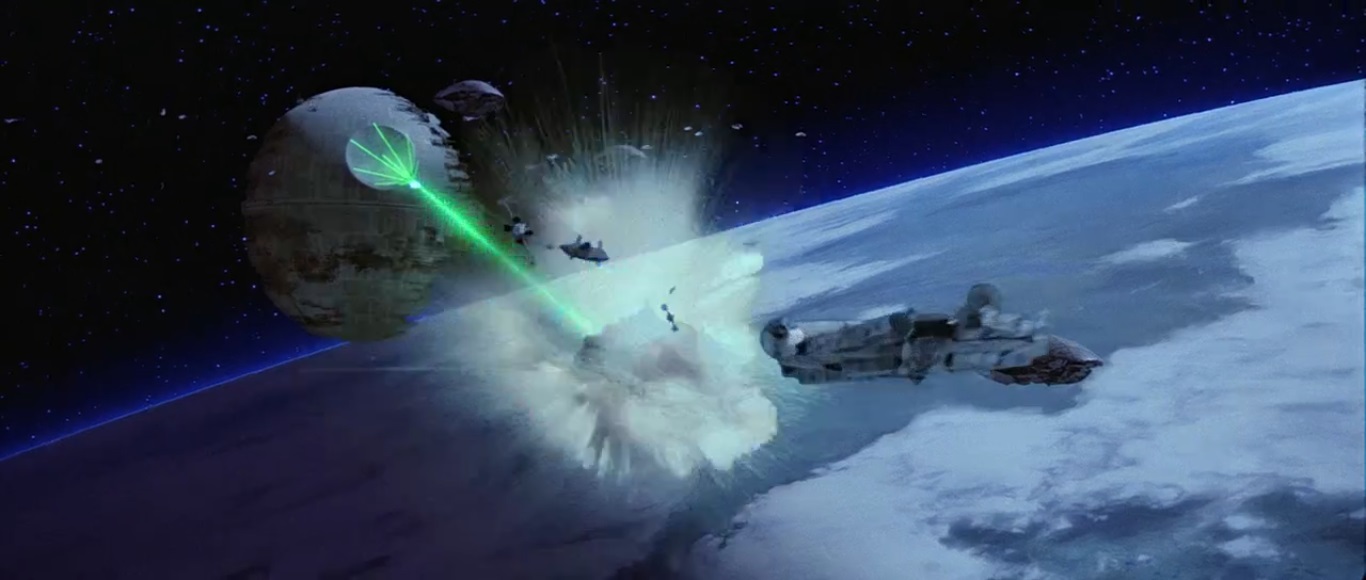
Without the Rebel success in the Battle of Endor on the ground on the forest moon, the entire attack would have failed and little if any of the Alliance
that came to Endor would have remained. The Rebel force which landed on the moon was vastly insufficient to deal with an Imperial garrison of
this size which knows they are coming and intends to capture them. The only reason the Rebels succeeds is because Luke and Han insisted on finding
Leia, and that Chewie got lured into an Ewok trap by a dead animal. Without the help of the Ewoks, not only would the Rebels have lost the battle,
and been captured or killed, but the incredible shift in momentum in the galaxy which occurred as a result would never have happend. In short,
the Ewoks defeated the Empire, and they did so because the Empire ignored them as unimportant and primitive, and had no fear of operating
on their homeworld despite their massive numbers. The Ewoks are themselves small and technologically unsophisticated, and thus the Empire
doesn't even consider them a threat, or care that they are in proximity to their secret project. The Ewoks hid the Rebel leadership for the night
and provisioned them, helped them find the secret entrance to the Imperial base, then set up a diversion and willingly entered a battle against
devastatingly superior forces to help people they just met. The Ewoks may have in some part wanted to expel the Empire and their machines
from their forest, but would never have made the effort they did on their own. They did what they did not to gain anything for themselves, but
instead to help their new friends, whose inspiring story they all heard, leading them to volunteer. These ignored and underestimated native
people were overlooked as a threat, and yet all the technology of the Empire couldn't overcome their knowledge of their land and its nature.
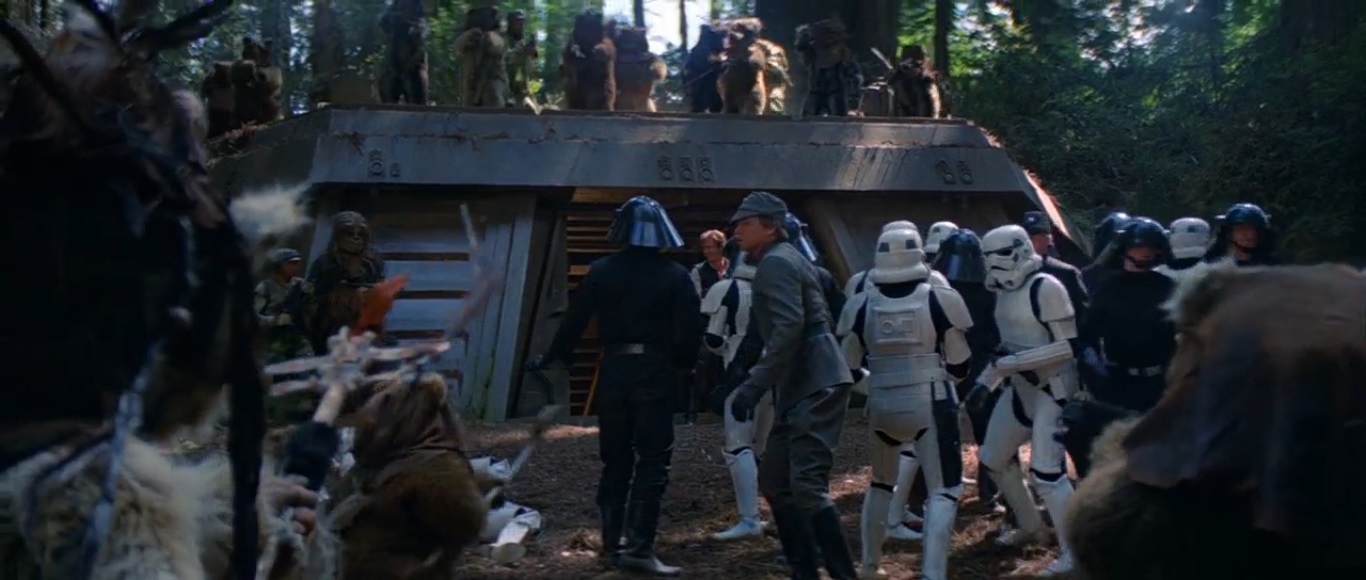
Sidious does his best to provoke Luke, as he is already acting like Luke's master and teacher, and calling Luke his "young apprentice." Talking down
to Luke and suggesting that his Jedi teachers have been holding back teaching him the reality of the Force is exactly how Anakin was goaded into
releasing his emotions and acting upon his passions. Sidious orders Luke to use his lightsaber and kill him, knowing of course that Vader will fight
for him. This is intended to get Luke to act on his emotions and release his anger, but also to demonstrate that Sidious need not fight because he
controls Vader, and Vader will always fight for him and protect him. There is no overcoming him without overcoming Vader. This is exactly what
Sidious intends, as the Sith test their apprentices and replace their masters by lethal combat, as those who win obviously have the will of Force
behind them. If Luke kills Vader, then Luke can become Vader, just as when Anakin killed Dooku and replaced him as Sidious' apprentice. If Luke
is killed the stronger survives and Luke is dealt with, if not, Sidious will once again have a younger, super-powerful apprentice. Although Sidious
believes it is highly improbable, if Luke somehow does strike him down in anger, Luke will theoretically join the dark side, meaning that at the least
the Jedi will again be gone and only the Sith will remain. This is always plan B for Sidious, as he is supremely selfish and self-interested.
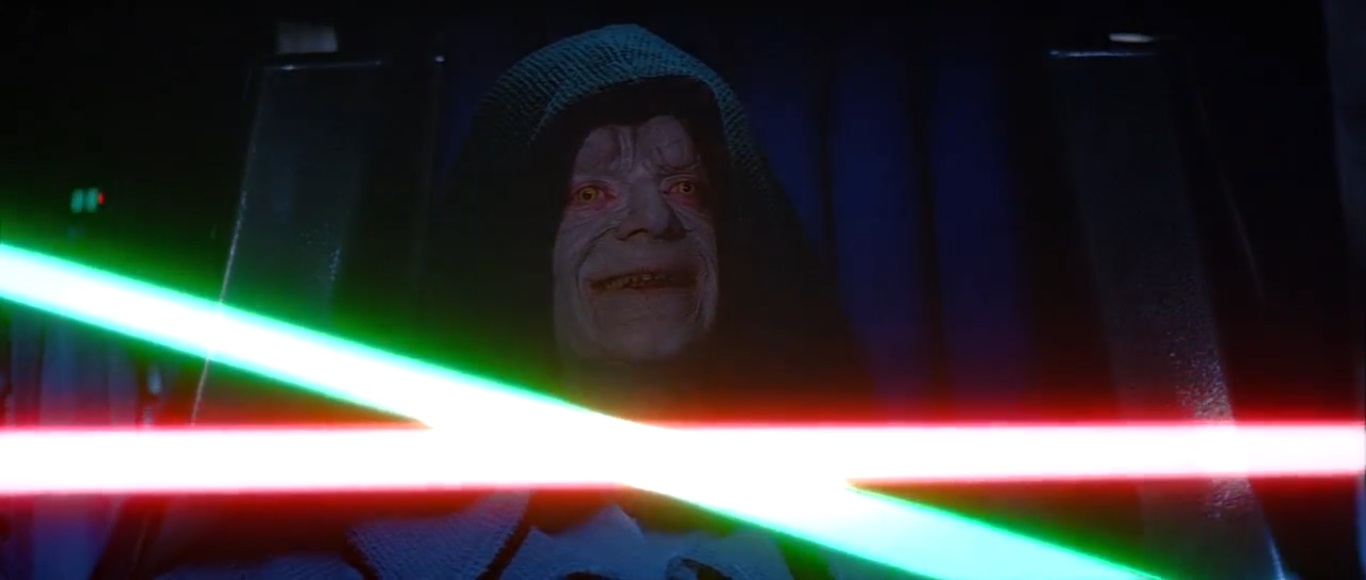
The rage, and even hatred, required to defeat the Sith is why confronting them is a trap. While it is possible to defeat a Sith without taking their place,
it requires mastery of one's own emotions, and usually is done in defence against a Sith attack. Luke's success in his fight with Vader first comes when
he is focused and centered, acting as a conduit for the Force as a Jedi should. Nevertheless, in fighting Vader he not only defends but attacks, leading
Sidious to celebrate him using his "aggressive feelings," thus revealing the true trap of the Sith is that confronting them empowers the dark side.
The only way to truly defeat the Sith is not to fight them, nor to surrender, but to deny them the conflict which they are seeking to fuel. Practically,
that usually still requires some kind of combat with them, which Luke handles like a Jedi Knight. Seeking to take the higher ground and stop the fight,
Vader, assures him that he will either fight and fuel conflict or be killed. When Luke's thoughts reveal Leia to Vader, leading Vader to provoke Luke
by threatening her, Luke is thrown out of balance. His Jedi discipline had been keeping his conflict over fighting Vader or saving Vader from undermining
him, but now he is fighting for someone else like a Jedi while at the same time fighting out of fear and anger like a Sith. Like Anakin's confrontation with
Dooku, Luke's refusal to accept his destiny to join the dark side leads him to try and destroy the Sith Lord who embodies that destiny, in this case Vader.
As he did with Anakin, Sidious applauds this, and tells Luke, "your hate has made you powerful. Now, fulfill your destiny and take your father's place at
my side!" It is clear that Luke was better prepared for his crisis point and confrontation with Sidious than Anakin was, since Luke looks at his father's
exposed mechanical hand, then to his own mechanical, black-gloved hand, and realizes how much he is becoming like his father.
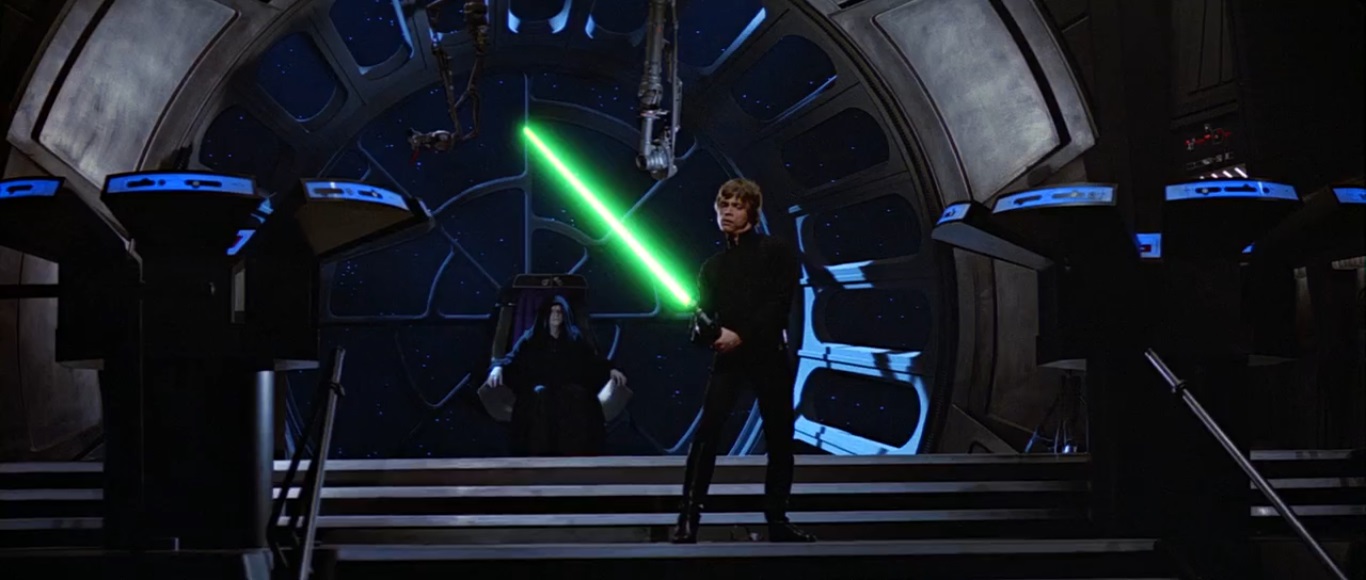
When Luke refuses to kill his father even after being fully provoked emotionally, Sidious directly confirms that Luke is indeed a true Jedi. Sidious of course
finds this distasteful as he believes the Jedi to be a twisted philosophy which attempts to hold him and everyone else back from reaching their potential.
It is clear that Luke's piety disgusts him, but even more troubling is the fact that things are not going according to plan, and that he did not see this
coming. Vader was able to prove that Luke was not better than him, and was just as capable of acting out of anger as he was. Luke now turns this around,
telling Sidious, "I'll never turn to the dark side. You've failed, Your Highness. I am a Jedi, like my father before me." If Luke is capable of standing up and
becoming a Jedi, even after Sidious manipulated him and made him fight out of anger, then Anakin can do the same thing. Luke being willing to die for
his beliefs and to try and save his father like a true Jedi, makes Anakin feel pride in Luke and shame about his own weakness, and finally succeeds in
Anakin making the decision to finally free himself from Sidious and save his son. Anakin is the hero of the story, who fulfills the prophecy of the Chosen
One by taking out both Darth Vader and Darth Sidious simultaneously by abandoning his hatred and killing the galactic tyrant once and for all.
Anakin's story arc was intended as an illusion to the United States and the Vietnam War. Anakin represents how the United States was once a noble but
severely flawed Republic, which out of its desire for order and dominance became imperialistic, and ended up committing horrible atrocities like in
the war in Vietnam. Vader is meant to illustrate that just because the United States has done some terrible things does not mean it has to keep being
an agent of imperialism and oppression, it can instead reconnect with the good that it used to want to be, and find redemption. Less specifically, Vader
is a classic example of the triumph of the human spirit and the possibility of redemption which is meant to remind us that even the worst people can
find their way to goodness, if they have the will. The return of the Jedi is threefold, as Luke proves himself a Jedi Knight, one of the Jedi of old, Anakin
Skywalker, returns as a Jedi for a brief but critical time, and Leia begins to access her abilities with the Force, heralding a brighter future.

The Battle of Endor was the pivotal battle in the Galactic Civil War which completely reversed the tide of war and turned the Rebels from a struggling
insurgent movement into a galaxy-wide revolution. The success of the Rebel strike team and its Ewok allies in bringing down the shield generator
allowed the Rebels to launch their fighter attack against the unfinished Death Star. The unlikely destruction of the Imperial super star destroyer leading
the fleet was a huge swing in the Rebels' favor, and helped them to buy time for the fighters to attack the Death Star's main reactor. Rebel losses in
the battle were moderate, and certainly within the realm of acceptable losses for what was accomplished in this battle. Rebel starfighters took
the greatest losses percentage-wise, however personnel-wise the destruction of several star cruisers were their most serious losses. At least two
Rebel cruisers were vaporized by the Death Star, and while a few more ships were undoubtedly lost in the close range assault on the Imperial fleet,
the majority of Rebel cruisers are seen at the end of the battle to have survived, although many may have taken serious damage. Despite their
advantage in fleet size and quality, as well as their use of an operational Death Star, Imperial losses in the battle were unacceptably high. Not only
was their command ship taken out with relatively little effort by the Rebels, but several Imperial-class destroyers were also entirely destroyed with
many others taking battle damage of varying severity. With their flagship destroyed, the spacestation they were guarding lost, and the Emperor dead,
the remaining Imperial destroyers abandon whatever troops are still alive on the surface and withdraw from the battle and the Endor system.
The tenacity of the Rebel Alliance turned a battle they were soundly losing into a virtual rout of the Empire's larger and better equipped forces.
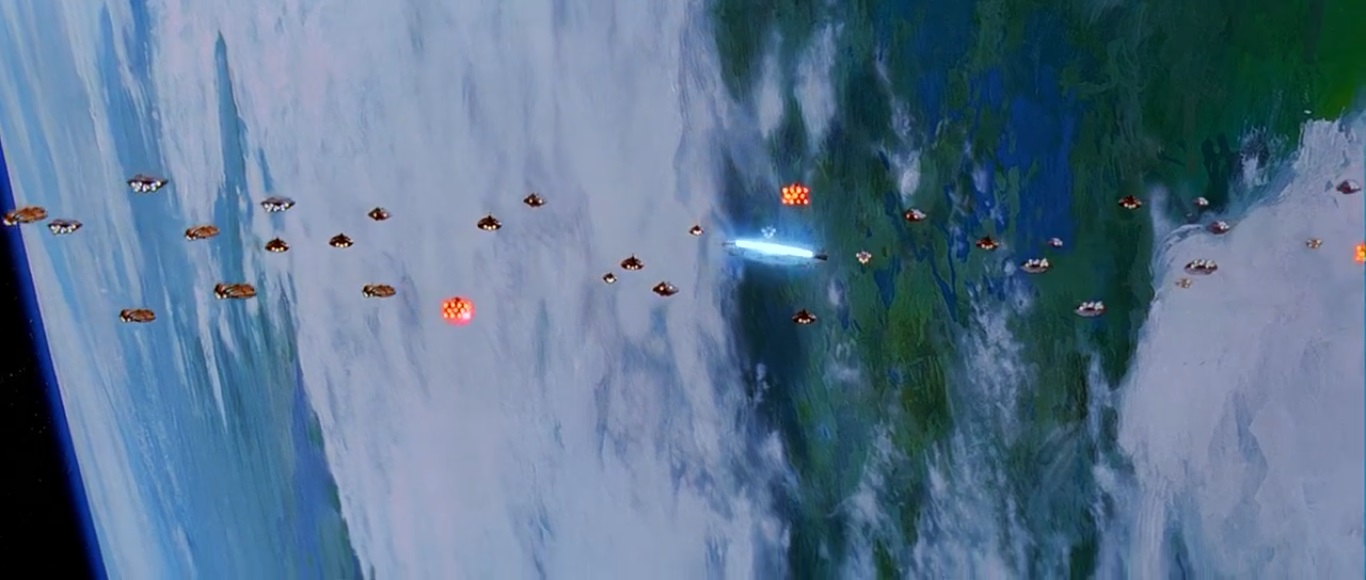
The death of Palpatine generated the same excitement and feeling of liberation that often accompanies the downfall of an oppressive tyrant.
It is clear that the Rebels broadcast images and this news at the first opportunity, which not only brought a great sense of hope and thoughts of
freedom to inspire greater rebellion, but also served to undermine the stability of the entire Imperial government. If the Emperor and a Death
Star and an Imperial fleet can be destroyed and defeated, no Imperial position is truly safe. This will embolden rebellions, decrease morale and
loyalty amongst Imperial troops, and lead to a general lack of faith in the long-term viability of the Empire. The power vacuum created by the loss
of Palpatine and Vader will destabilize huge numbers of Imperial planets, and lead to endless power-struggles and internal wrangling on planets
and in starsystems where Imperial rule temporarily remain stable. The galactic parties and ultimate uprisings shown indicate that the Empire is
instantly destabilized in the Core, and even the Imperial capital of Coruscant is no longer securely under Imperial control. Over the next year,
this instability will lead to the fracturing of the Empire's remaining holdings under competing leaders. After the defeat of the primary Imperial
remnant a year later, the Galactic Empire will have officially fallen, although several Imperial remnants will remain as rump-states. This does not
mean that the outcome of the war was already certain, and indeed the next year of war was devastating to the galaxy, however the momentum and
progress of the war which the Empire largely enjoyed up to this point have swung entirely in the direction of the Alliance to Restore the Republic.
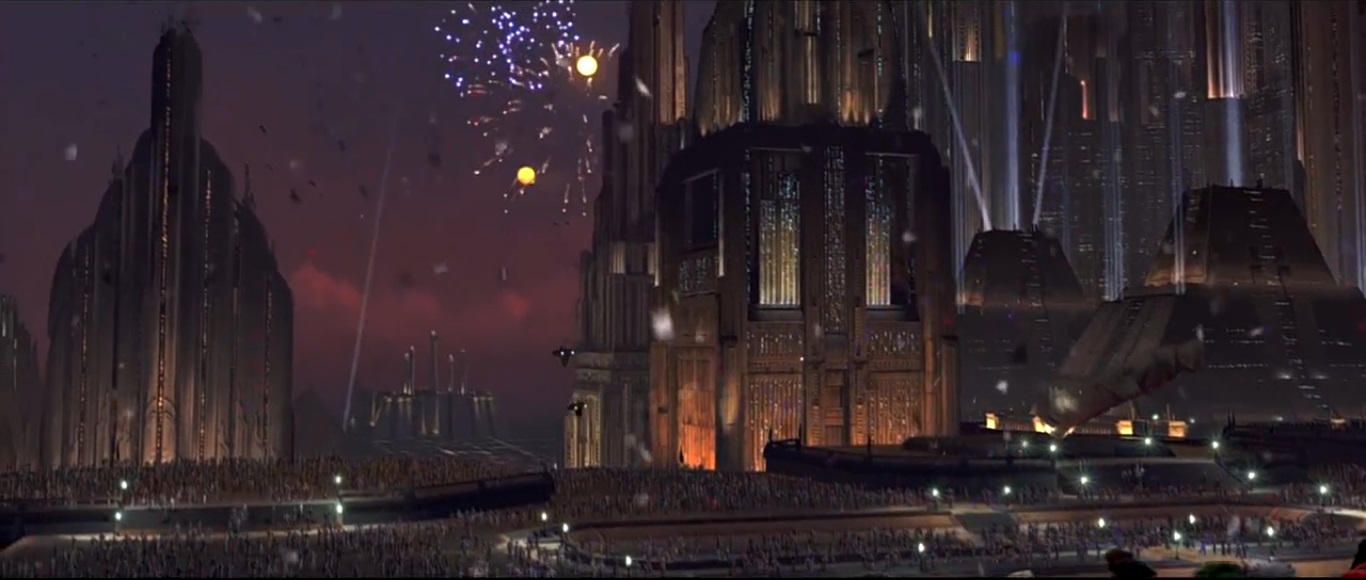
The Jedi win their struggle against the Sith from beyond the grave through the teachings and spiritual achievement of Qui-Gon. While the Jedi Council
treated Qui-Gon's piety towards the Force as inconvenient to their pragmatic and politically-minded approach, the two members of the Council to
survive the Clone Wars were able to reflect on their failure. The compromise with corruption and tolerance of evil necessary to play the game of
politics left the Jedi susceptible to manipulation by the Sith, whereas a religious devotion to the light side of the Force would have led them to make
many different choices. Qui-Gon's abilities as an entity in the Force slowly grew to the point of communication with Yoda, who eventually taught
Obi-Wan how to commune with him, leading both to learn how to fully transform into the Force at the moment of death. Sidious had defeated
the Jedi by enacting a plan they didn't expect and could not see coming, due to the growing veil in the Jedi's vision through the Force. Qui-Gon's
alternative philosophy proposed defeating the Sith with spiritual enlightenment rather than large numbers of Jedi warriors and military forces.
By learning to manifest a consciousness after death, and to commune with the living, Obi-Wan and Yoda continued to teach and aid Jedi, becoming
essentially undefeatable. Most importantly, as the materialist Sith do not believe in Jedi spirits living on after death, this is a plan Sidious doesn't
expect and can't see coming. Sidious and his unnatural concentration of dark side energy are now gone, the balance in the Force has been restored to
something approximating its natural state, Anakin has been redeemed and joins his friends in the netherworld of the Force, and the Jedi have returned.
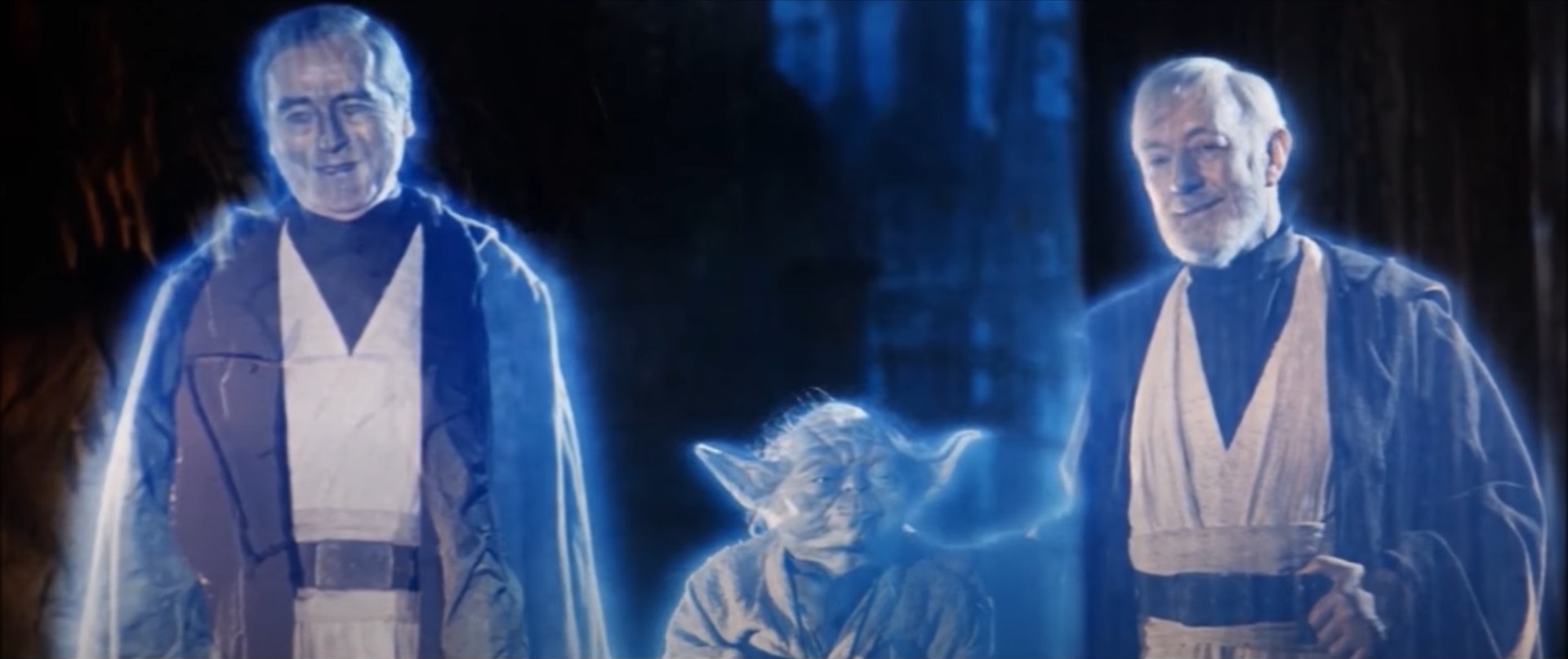
From Deleted Scenes
While the scene was not deleted, several lines of important dialogue for Obi-Wan which are found in the script and were filmed were removed during
the editing process as they were deemed unnecessary to the scene and story. Regarding keeping the truth about Vader being his father, Obi-Wan
tells Luke, "I don't blame you for being angry. If I was wrong in what I did, it certainly wouldn't have been for the first time." Obi-Wan is clearly aware
that his some of his choices have been ethically dubious, and is the first to admit that he isn't perfect and has failings like any Human. Obi-Wan was
also to tell Luke, "what happened to your father was my fault", suggesting that Obi-Wan still blames himself for Anakin's choices. Obi-Wan was also to
have said "My pride has had terrible consequences for the galaxy. I also thought he could be turned back to the good side. It couldn't be done."
This was just before he says of Vader "He is more machine now than man. Twisted and evil." Obi-Wan is explaining to Luke that it wasn't anything
personal towards Luke, and that while it is highly personal to Obi-Wan, he did what he did because of what it means to the galaxy. Obi-Wan feels
responsible for everyone who has suffered because Obi-Wan believed he was capable enough to train Anakin, and then believed he could convert
him back after he became Vader. Obi-Wan is still a bit arrogant about the subject, as he suggests that Anakin is lost forever simply because he was
unable to reach Anakin, which Luke of course shows later is still possible to do. Ultimately, despite the loss of his friend Anakin, his victory against
Vader on Mustafar only made all of this a problem because Obi-Wan left Vader for dead when in fact he was still alive. Conversely, at that point
Vader had already done irreparable damage to the Jedi Order, and it is not the Jedi way to kill a wounded and unarmed enemy.
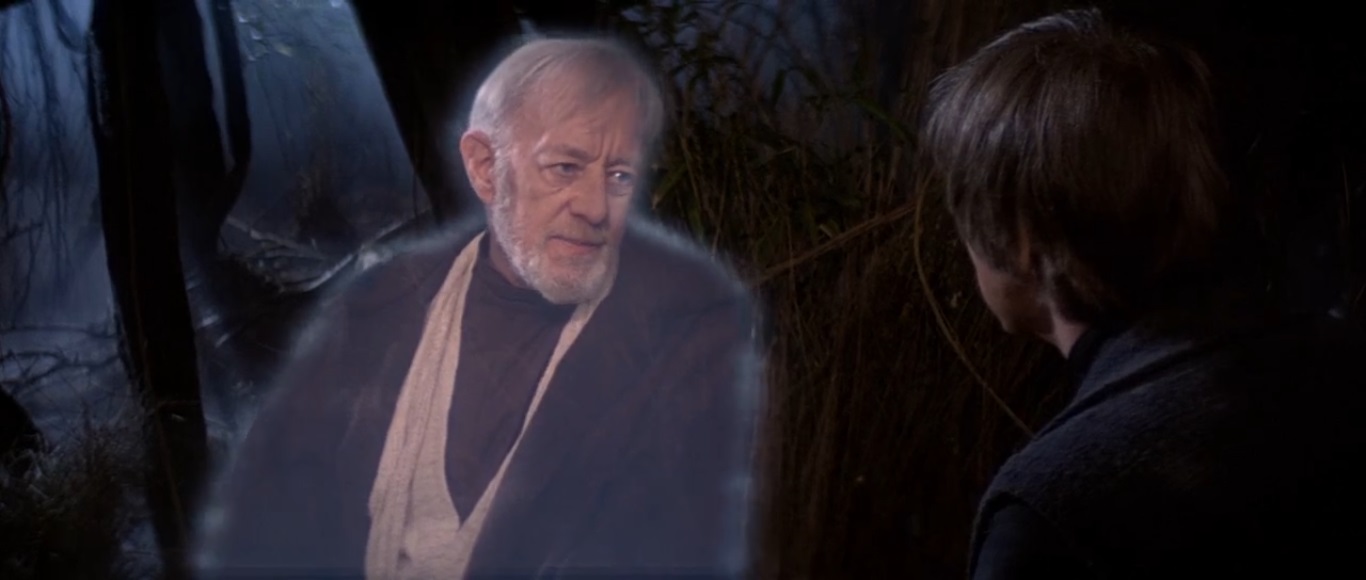
Moff Jerjerrod stopping Vader at the elevator shaft at the base of the Emperor's tower on the Death Star is highly illustrative of the dynamic within
the Imperial power structure. He pointedly tells Vader, "You may not enter", leading Vader to choke him with the Force. Jerjerrod manages to
tell Vader, "it is the Emperor's command", leading Vader to desist and remark, "I await his convenience." Jerjerrod is competent and loyal to
the Emperor, but does seem to feel himself important enough to throw it in Vader's face that he gets his orders directly from the Emperor. It is
also clear that Vader is afraid of no one but Sidious, and that he feels that he can basically do what he wants, unless something was ordered
by Sidious. This interaction was meant to illustrate that for all Vader has done and given to Sidious and the Empire, he is still not a member of
the ruling circle. This is an intentional exclusion by Sidious, who does not wish Vader to gain any political power, or be placed in a position where
he might entertain notions of overthrowing him. Sidious placates Vader's ego by speaking to him as his only "friend" and giving Vader the respect
he would only give to a fellow member of their secret society. At the same time, Vader is constantly reminded of his failures, spoken to diminutively
as an apprentice, kept out of the Imperial power structure and decision making process, and ordered about like a slave rather than consulted.
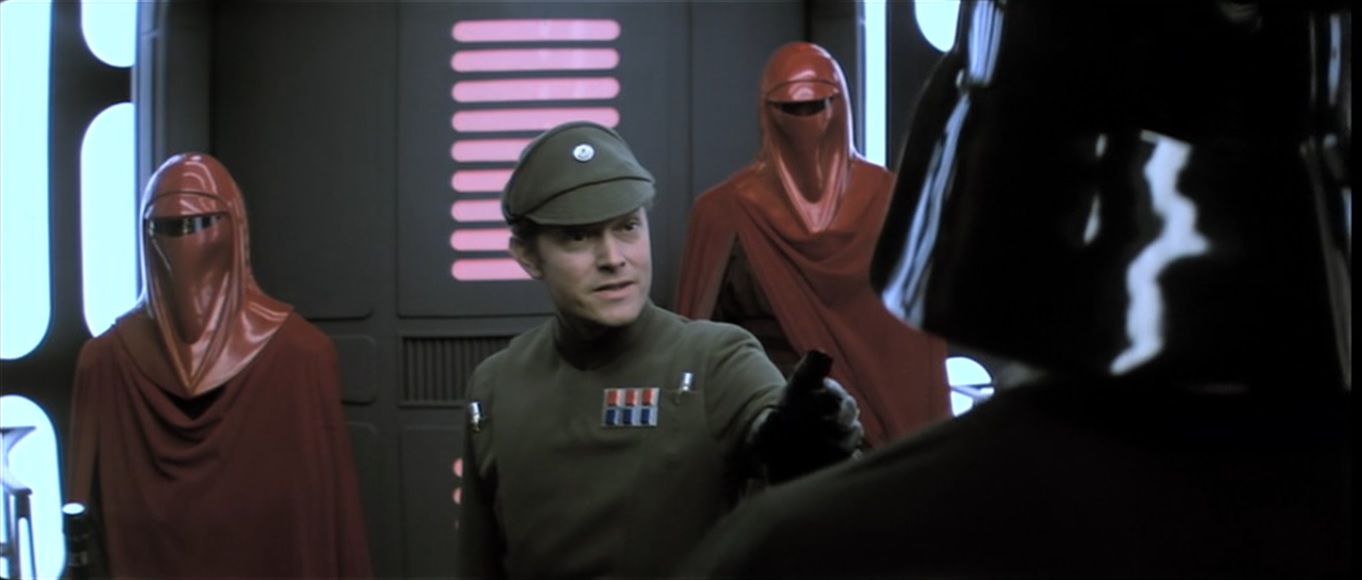
The Emperor tells Jerjerrod, "should the Rebels manage to blow up the shield generator, you will turn this battlestation on the moon and destroy it."
Jerjerrod's response, "but we have several battalions stationed on the moon", is dismissed by Palpatine as unimportant. Jerjerrod's displeasure
with this is noticeable, as he is clearly a loyalist and respects his fellow members of the Imperial military, but is obviously going to do what the Emperor
tells him to do. One does not become a Moff, which is an Imperial sector governor, without being something of an opportunist or a political climber.
Despite this, Jerjerrod is the type of successful officer who earned that position with loyalty, capable leadership, and actual results. His concern for
his hard-working men was evident in his first conversation with Vader at the opening of the film. As shown in the last of this sequence of deleted
scenes and conversation, Jerjerrod is reluctant to begin the firing sequence even when the station has turned and the moon is in firing range,
but does still proceed. Officers like Jerjerrod are likely the most common kind in the Imperial military, those who don't see any significant difference
between the Republic and the Empire, and who see the extra security, militarism, and elitism of the Empire as a positive thing. The true nature of
the Empire as a Sith organization sometimes makes the orders they receive unpalatable, however as obedient soldiers they will still do their duty.
Jerjerrod does not want to kill his own, loyal troops, and the fact that the Emperor has no concern about this has to bother even the most loyal officer
of this kind. Those less common officers who joined the Empire because they are enthusiastic about tyranny would be all too happy to follow such orders.
The realities of fielding a capable military dictate that honest patriots will almost certainly outnumber the fanatical within its ranks, even in an empire.
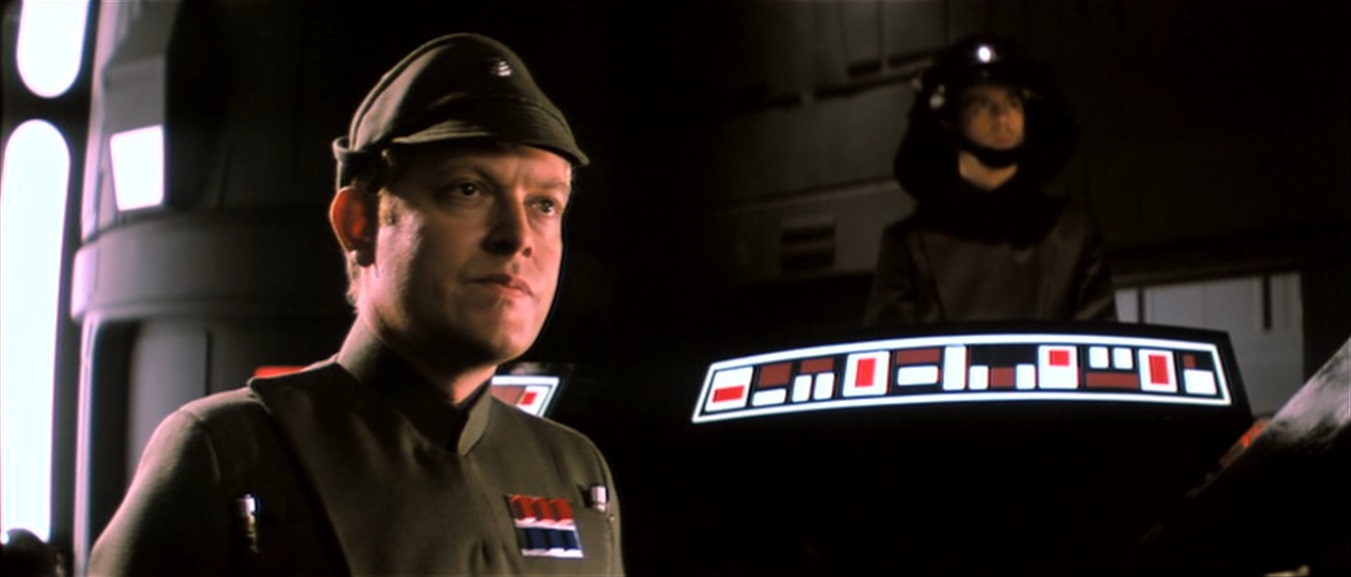
FURTHER ANALYSIS
The Importance of Luke Skywalker
George Lucas Explains why Luke Skywalker is Vader's Equal in Return of the Jedi
The Mythology of Star Wars with George Lucas and Bill Moyers